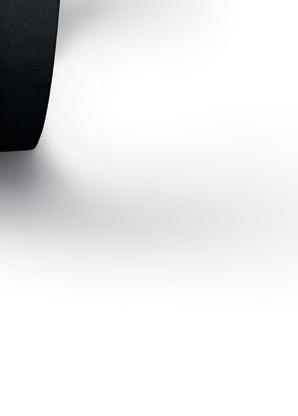






07 The brief

An insight into the news and trends shaping the region with perceptive commentary and analysis












An insight into the news and trends shaping the region with perceptive commentary and analysis



How Mohammed Bin Saleh Albuty, CEO of Saudi-based National Housing Company, is driving the transformation of Saudi Arabia’s real estate sector



We reveal the winners of the 10th edition of the Gulf Business Awards





Hublot is bang on trend

The brand’s regional director, David Tedeschi, tells us why p.60
“We
Force to reckon with Abu Dhabi is raising its profile as the region’s jiu-jitsu capital p.64

The suave SUV Aston Martin’s DBX is big on style and performance p.68
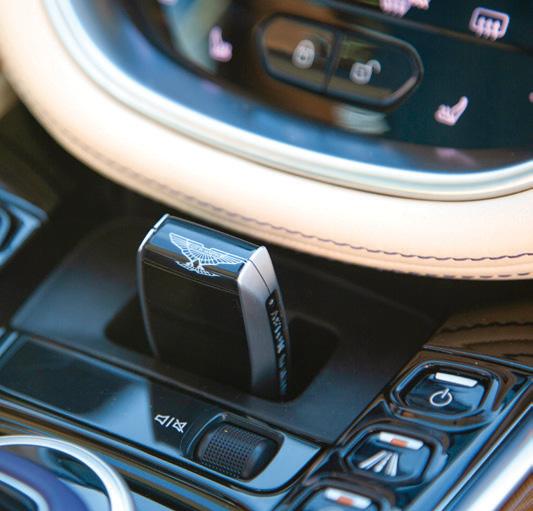

Interviews with entrepreneurs and insights from experts on how the regional SME ecosystem is evolving
Cover: Freddie N. Colinares
HEAD OFFICE: Media One Tower, Dubai Media City, PO Box 2331, Dubai, UAE, Tel: +971 4 427 3000, Fax: +971 4 428 2260, motivate@motivate.ae DUBAI MEDIA CITY: SD 2-94, 2nd Floor, Building 2, Dubai, UAE, Tel: +971 4 390 3550, Fax: +971 4 390 4845 ABU DHABI: PO Box 43072, UAE, Tel: +971 2 677 2005, Fax: +971 2 677 0124, motivate-adh@motivate.ae

Carbon dioxide emissions from building construction and operations hit an all-time high in 2021, according to the most recent data, a sign that the push to decarbonise the industry by 2050 may be slipping out of reach.
Energy-related emissions from the operation of buildings reached 10 gigatonnes of CO2 equivalent, 5 per cent higher than 2020 levels and 2 per cent more than the pre-pandemic peak in 2019, according to data compiled by the Global Alliance for Buildings and Construction (GlobalABC). Operational energy demand in buildings for heating, cooling, lighting and equipment rose about 4 per cent from 2020 levels, the group said.
While investments in building energy efficiency increased 16 per cent last year to $237bn, the growth in floor space outpaced efficiency efforts. As a result, “the gap between the climate performance of the sector and the 2050 decarbonisation pathway is wid ening,” the report concluded.
Buildings were the source of 37 per cent of global CO2 emissions in 2021, which includes emissions derived from the production of concrete, steel, glass and other building materials. Reducing the sector’s emissions has therefore become vital to the larger goal of decarbonising the global economy.

Construction activities in most major economies returned last year to pre-pandemic levels and energy use rose as offices reopened. More emerging econo mies also increased their use of fossil fuels in build ings. That caused energy demand for buildings to climb about 4 per cent from 2020 levels, the largest advance over the past decade, GlobalABC said.
Cutting emissions from residential buildings holds great promise, but is hard to achieve. “It’s
difficult to motivate billions of building owners to take action,” said Adrian Joyce, director of Renovate Europe, a campaign group that wasn’t involved in the GlobalABC report, in an interview. “And, as for politicians, they are reluctant to impose obligations on individual homeowners.”
More countries now include buildings in their cli mate pledges under the Paris Agreement, which are known as Nationally Determined Contributions, or NDCs. The number of NDCs that mention buildings rose to 158 in 2021 from 88 in 2015, according to the report. However, only 26 per cent of countries have mandatory building energy codes for the buildings sector. Progress is also being hampered by the crisis in the Ukraine, which has led to higher fuel costs and made everyday life more expensive for millions across the world. Cash-strapped homeowners are reluctant to install expensive heat pumps, revamp insulation or switch to energy-efficient windows without substantial help from governments.
“The solution may lie in governments directing relief towards low and zero-carbon building invest ment activities through financial and non-financial incentives,” said Inger Andersen, executive director of the United Nations Environment Program, in a statement accompanying the report.
Reducing the construction sector’s emissions has become vital to the larger goal of decarbonising the global economy
BUILDINGS WERE THE SOURCE OF 37% OF GLOBAL CO2 EMISSIONS IN 2021
nature-based solutions to travel the net zero journey. Similarly, Egypt announced an agreement for clean hydrogen production with Europe and launched the ENACT initiative with Germany to protect land and ecosystem degradation, and biodiversity loss through nature-based solutions (NbS).

During the Saudi Green Initiative in Sharm Al Sheikh, Saudi Arabia announced 840MW of solar PV projects would be completed by 2023, with an additional 13 renewables projects with 11 GW capacity under development. It also announced the creation of one of the largest carbon capture and storage (CCS) hubs in the world in Jubail, expected to be operationalised by 2027.
With climate change looming large, scientists have been warning that the Middle East is warming at twice the global average. Do you see countries in the region accelerating their net-zero initiatives to mitigate this?
QHow do you think COP27 has helped countries, particularly in the Middle East, align with UN Sustainable Development Goals and Net-Zero 2050 targets?
The Middle East and North Africa (MENA) region is one of the most vulnerable places to the impacts of climate change. The region is warming at twice the global average and is projected to be up to 4°C warmer by 2050. This would also have a compound e ect on food and water security of the region.
To mitigate this, some of the largest economies in the region have announced net-zero ambitions (UAE and Oman by 2050, Saudi Arabia and Bahrain by 2060), and have mobilised significant resources towards the e ort.
The 2022 United Nations Climate Change Conference or Conference of the Parties of the UNFCCC, more commonly referred to as COP27 and associated events have been instrumental in driving climate awareness and action from governments in the MENA

region. For example, during COP27, the UAE unveiled its pathway to net zero, which sets the timeframe, targets and mechanisms for achieving it by 2050. It envisages the scale up of various technology-based solutions (TbS) such as renewables, industrial carbon capture, utilisation, and storage (CCUS) systems, direct air capture (DAC) alongside
Countries in the MENA region have taken the concrete steps towards announcing climate commitments by launching and recently updating their nationally determined commitments (NDCs). Some of the largest economies such as Saudi Arabia and UAE have announced 26 per cent and 31 per cent reduction in their emissions by 2030 from the “business-as-usual” level. As next year’s COP28 is going to implement the first global stocktaking process (GSP), it is a great opportunity for countries across Middle East to showcase their e orts and achievements.
One of the challenges is to translate this government ambition to action on ground by businesses. We, at Bain, in partnership with World Economic Forum, recently analysed that only 12 per cent of MENA’s 200 largest publicly listed and private companies have identified a net-zero target, and only six per cent of them have established a roadmap to reach there (which is a 50 per cent funnel drop). Another challenge is the capability gap in the region with human resources trained on sustainability topics, with understanding of globally accepted frameworks, methodologies and best practices. And finally, there is a challenge with low consumer awareness and willingness to pay a premium for some of the cleaner and greener options, what we call consumer-backed decarbonisation.




Dharmendra Hiranandani, senior manager, Bain & Company
FROM SOLAR ENERGY TO SUSTAINABLE FUEL AND GOVERNMENT INITIATIVES TO STEPS TAKEN BY THE PRIVATE SECTOR, HERE’S HOW IT’S BEING DONE
TO COMBAT CLIMATE CHANGE?
There are several avenues where global or regional collaboration can lead to fruitful outcomes. Some of these areas are:
Harmonisation of disclosure require ments, frameworks, and methodologies: Regulators across the region could sync up their emissions regulations including frame works and methodologies and align them with global best practices to simplify report ing for businesses.
Collaboration on breakthrough technolo gies: Some of the breakthrough pathways such as green hydrogen, or direct air capture are at different levels of technology readi ness and need significant resources for their scale up. Therefore, a joint collaborative effort to scale these technologies will reduce the fragmented efforts and improve technol ogy feasibility. For instance, there could be a regional collaboration on transport infra structure of clean hydrogen.
Mobilisation of sustainable finance: While there have been significant efforts in this direction, more collaboration is possible to mobilise innovative sustainable finance products (green sukuks). One possible example of this collaboration would be to scale up the common carbon market for MENA region where buyers and sellers can trade carbon credits. The carbon markets could be a tool to mobilise project finance for carbon removal or avoidance projects that generate carbon credits in the region.
Capability building: Governments across the region can introduce a common education curriculum and vocational training to bridge the capability gap in the sustainability ecosystem. This would also generate green jobs for the local population.
utilities, ACWA power has 37 per cent of its generation capacity from renewables. It is also involved in building one of the largest green hydrogen plants globally at NEOM. Similarly, Abu Dhabi National Energy Company (TAQA) and Egyptian Electricity Holding Company have targeted 30 per cent and 42 per cent renewables by 2030 and 2035 respectively.
When it comes to aviation, another hardto abate sector, Etihad has been actively involved in scaling up sustainable avia tion fuel (SAF) and recently flew its first flight with a 40 per cent blend of SAF from Tokyo. Saudi Aramco has plans to establish 11 Mtpa capacity of blue ammonia produc tion facilities by 2030 and operationalise 11 Mt CO2 CCUS capacity by 2035. Similarly, Ma’aden and SABIC have also announced blue ammonia plans. Apart from hard to abate sectors, companies from other sectors such as telecom are also taking strides in the decarbonisation journey. For instance, e& (formerly Etisalat) has recently announced a net-zero ambition by 2030.
How do you see the Middle East harnessing cleaner energy sources?
The Middle East has tremendous renewables resources. The region is blessed with high levels of solar irradiance or the power per unit area received from the sun. Coupled with clear sunny days, this results in highcapacity factors and lower cost. The cost of electricity has dropped to almost 1 cent per kWh in Saudi Arabia, compared to global average of 5 cents per kWh as per IRENA. Same is true for other MENA countries too, given similar geographic conditions. Further, low solar energy costs enable the advancement of another breakthrough pathway – green hydrogen.
The private sector needs to shoulder its responsibility and be the vehicle for delivering climate action. As per our analysis of the largest 200 companies, green shoots are definitely visible. For example, 41 per cent of the companies have started disclosing their scope 1 and scope 2 emissions. However, there is opportunity to increase transparent and consistent disclosures. For instance, globally over 13,000 corporates disclosed their emissions to the Carbon Disclosure Project (CDP) in 2021, up from close to 6,000 companies just five years back. However, in the MENA region, only 7 per cent of the companies (of over 200 analysed) have CDP disclosures. Similarly, only four businesses have aligned their targets with SBTi, a global standard for reduction targets, compared to over 3,400 businesses globally.
The UAE is preparing to host COP28 in 2023. How do you see the country meeting its 2050 net-zero targets?
As the host for next year’s COP, UAE has led the target-setting effort on two specific dimensions. First, it has announced a roadmap to achieve net zero by 2050, which clearly determines the reduction targets by each decade as well as the mechanism to fulfill them. Second, it has upgraded its NDC and pledged to cut 31 per cent emissions by 2030, compared to business-as-usual emissions, up from 23.5 per cent announced in 2020. Beyond target setting, the business ecosystem in the UAE is also demonstrating greater awareness and action. Of the subset of the 35 largest UAE companies from our database, approximately 80 per cent have started measuring scope 1 and scope 2 emissions and around 30 per cent have set net-zero targets, which are starkly higher than regional averages.
There are several instances of companies from hard-to-abate sectors taking lead in scaling up various decarbonisation pathways. For example, from power and
Similarly, the region is also blessed with natural geological formations for developing CO2 sequestration facilities. Having CCS potential is critical for development of blue hydrogen, which is an essential transitional fuel as the greener version scales up.
As Dubai prepares to host COP28 in 2023, the region’s businesses will be expected to demonstrate a greater commitment than usual. Likewise, action is expected to increase from all the stakeholders, includ ing governments and regulators. All eco system players, including policymakers, businesses and financiers, would need to move in lock-step to achieve the net-zero transition for the region.
How can countries work together today in new, innovative ways to secure a cleaner, fairer future for everyone?
Who are the key players taking the lead in decarbonisation?
SAUDI ARAMCO HAS PLANS TO ESTABLISH 11 MTPA CAPACITY’S BLUE AMMONIA PRODUCTION FACILITIES BY 2030 AND OPERATIONALISE 11 MT CO2 CCUS CAPACITY BY 2035”
Bahrain also launched its tendering pro cess to award the contract for a 72MW solar project in the kingdom in August, while Oman’s 500MW solar plant was inaugu rated in January, becoming the first solar IPP (independent power producer) project to connect to the main national grid.
As is common knowledge, solar power can be used to furnish a range of personal and commer cial purposes – it is harnessed from a relentless natural source and the generation of solar energy itself produces no emissions. In fact, it is estimated that the amount of sunlight that strikes the Earth’s surface in one and a half hours is adequate to power the entire world’s energy con sumption for a year.

Leveraging the world’s dominant energy source and to mitigate a looming environ mental crisis manifesting in the form of rising temperatures and drastic climatic events, there has been renewed commit ment globally to increase the share of renewable energy in the overall mix.
The GCC region is no different as it steps up the shift to renewable energy through the launch of ambitious projects. The fact
that the region receives sunshine in abun dance also helps the cause of solar energy production. Saudi Arabia, the GCC’s larg est economy, aims to produce 50 per cent of its electricity from renewable energy resources and the remaining from gas by 2030. In September, the kingdom announced five renewable energy projects to produce electricity, two of which will utilise solar energy and have a combined capacity of 1,500 megawatt (MW).
In October, QatarEnergy announced that it signed an agreement to fully acquire Siraj Energy, a solar power facilities operator. It also awarded a contract in August to build two solar power plants to generate 875MW of renewable energy. The project, along with the under-construction Al Kharsaa solar PV (photovoltaic) power plant, will increase the country’s renewable energy generation capacity to 1.675 gigawatt (GW) by 2024.
Locally, the UAE aims to achieve net-zero emissions by mid-century and has under taken multiple initiatives to bolster its solar energy production. In 2012, Dubai announced the Mohammed bin Rashid Al Maktoum Solar Park, the world’s larg est single-site IPP-based solar park. Imple mented by Dubai Electricity and Water Authority, the park is being built in phases and will have a production capacity of 5,000MW by 2030. Meanwhile, Abu Dhabi is home to the 1,200MW Noor Abu Dhabi solar plant and the under-construction 2,000MW Al Dhafra solar PV plant.
The UAE is keen to invest in renewable energy production beyond its borders as well. In March, Abu Dhabi-based renew able energy company Masdar announced the start of construction for its 230MW Garadagh solar PV plant in Azerbaijan. Last year, it signed an agreement with the Geor gian Energy Development Fund to develop a solar PV power project in the country. It also inked a strategic agreement with Iraq to develop five solar PV projects in the country with a combined capacity of 1GW, as well as secured a tender to build a $174m utility-scale solar project in Armenia. Masdar also inaugurated an office in Riyadh recently to expand its presence in the king dom and support its energy transition.
With enterprising renewal energy projects in place, the UAE and the GCC appear on track in their transition to a greener future.
The GCC has made considerable strides in increasing its solar energy production, says Zainab Mansoor
THE MOHAMMED BIN RASHID AL MAKTOUM SOLAR PARK WILL HAVE A PRODUCTION CAPACITY OF 5,000MW BY 2030

The quantitative analysis movement started in the 1950s with the introduction of Nobel Prize-winning economist Harry Markowitz’s modern portfolio theory (MPT), which showed investors how to con struct a diversified portfolio of assets capable of max imising returns for various risk levels. In the 1990s, the emergence of computers made it possible to crunch enormous volumes of data in extraordinarily short periods of time, advancing the field significantly.
Today, quant strategies have gained notable atten tion for their role in high-frequency trading (HFT) that relies on increasingly complex quantitative trad ing strategies, in which traders seek to identify con sistent patterns, model those patterns, and use them to predict price movements in securities.
It’s clear that technology has forever changed the world of investing and financial resilience. Not only can it grant companies a distinct advantage in an increasingly competitive world. But in today’s com plex and rapidly changing economic environment, financial players and organisations who fail to incor porate the power of mathematics and science in their financial approach and analysis are destined to be left behind.
The geopolitical and economic storm spurred by the Covid-19 pandemic over the past two years has sent unprecedented shockwaves across financial institutions, fintechs, hedge funds, banks and insurance companies.
Globally, as some governments attempt to revital ise their economies, several major markets are still teetering on the edge of recession, with organisations in the financial sector scrambling to find the answers to their most pressing questions.
The compass that will guide many of these com panies through choppy waters and help avert future market crashes will be quantitative financial analysis.
By combining state-of-the-art mathematical methods, computational skills and programming expertise, quantitative financial analysts, known as “quants”, work to develop and implement complex mathematical models that help financial firms and investors make informed decisions around risk man agement, investment opportunities and pricing.
Part speculator, part ruthless logician, quantitative analysts also adopt a disciplined approach to trading and valuing assets, with the aim of reducing risk and generating profits.
With this in mind, I foresee the demand for quantita tive financial analysts rising both rapidly and expo nentially in the future. Indeed, with increasingly complex financial securities, and the challenging nature of the work, there is great demand for quant professionals who understand the complex mathe matical models that price these securities.
Quantitative financial analysis is a highly compet itive field requiring individuals with multifaceted skills, tremendous financial knowledge, and the right temperament. Alongside an all-encompassing understanding of finance and experience in program ming, mathematics, and trading, a great majority of firms require at least a master’s degree, or preferably a doctorate, in a quantitative subject (mathematics, economics, finance or statistics) or financial math ematics as a prerequisite for this career path.
That being said, finding individuals with these skills is a challenge for companies. This puts those with the unique tools and knowledge possessed by quantitative financial analysts in an elevated position in today’s job market.
With the world still at risk of facing a recession in 2023, and a string of financial crises being seen across emerging markets and developing economies, com panies have never been so eager to employ analysts with the skills to anticipate risk, protect them, as well as capitalise on emerging opportunities.

The ability to apply mathematical and scientific knowledge to financial analysis holds the key to helping organisations navigate a looming recession, and that’s where “quants” come in
The resumption of international air travel following a slump during the pandemic signals a return to normalcy for the aviation indus try. According to IATA, international air traffic in May 2022 rose 325.8 per cent com pared to the same period last year. Middle Eastern airline traffic also rose 317.2 per cent in May 2002 compared to May 2021. As aviation is set to recover in 2023, it has turned the spotlight on sustainability. Cli mate change has already driven increased scrutiny around transport infrastructure around the world. We are seeing a shift to EVs and other green technologies that use resources judiciously and minimise waste and discharge. The UAE especially has made great strides in sustainable mobility with affordable and accessible transport ini tiatives under development.
Meanwhile, there is a surge in investments in multi-modal transport networks within the aviation sector to create hubs and reduce congestion. Global aviation already generates around 2.1 per cent of carbon emissions, however IATA estimates that the demand for air passenger journeys in 2050 could exceed 10 billion, driving emissions up even further. A net-zero target by 2050 for the aviation industry means it has to buckle
up and seriously assess its climate impact in the immediate future.
Decarbonisation is a key to minimise green house gas emissions. Transitioning to a low carbon economy while reducing direct and indirect emissions can go a long way in meet ing aviation sustainability goals. Earlier this year, the UAE announced ambitious plans to decarbonise the aviation sector.
A roadmap called ‘Power-to-Liquids’ drafted jointly by the Ministry of Energy and Infrastructure and the World Economic Forum (WEF) outlined the financial, economic and environmental benefits of bio fuels in decarbonising the country’s aviation industry. This is a tremendous step to reduce the reliance on fossil fuels and aligns with the country’s economic diversification ambitions. Technology adoption in aviation can also help streamline passenger movement and reduce waiting times. Automated border control gates and smart logistics for baggage handling can improve aircraft turnaround time and deliver efficiency and convenience for passengers. Airlines are already investing in quieter and better designed aircraft to optimise their fleet.
Aziz Ghorbani, general manager, Delta World Charter
This, coupled with more efficient taxiing and flight path optimisation, can also contribute to a reduced carbon footprint.
Meanwhile, leaner and greener construction in avia tion is also critical to meet global aviation sustainabil ity targets. Sustainable air port development, including harnessing solar power and alternative energy, as well as adopting cleaner construction practices, is where the future lies. Using local materials in the construction process, ensuring water conservation and waste reduction and hiring local talent can further reduce environmental impact.
Equally, building sustainable mobility that encourages behaviour change towards more sustainable travel can go a long way in minimising environmental impact. Offering sustainable alternatives to passengers, through enhanced route connectivity, purchasing carbon offsets, facilitating seamless e-check in, encouraging the use of public transport to get to the airport, and promoting sustainable food packaging, are a few ways to ensure better social and economic outcomes.
Sustainability has also become a key con cern in the private aviation sector, which has been investing in better aircraft and avionic technology to transition to a cleaner business model. Many private charters have leaner and lower fleet utili sation than scheduled operators. Further more, the shift to sustainable aviation fuel (SAF) is rapidly becoming a reality. Oper ators are also offering competitive carbon offsets programmes that fund renewable energy projects and help save rainforests. Even though sceptics remain unconvinced that the aviation industry can be truly sustainable, new technology, policy, and behavioural change are manoeuvring the industry to a greener future.
Offering corporate clientele additional tools to meet their ESG goals by offsetting emissions and other carbon neutral programmes can ensure that the burden of responsibility is shared between operators and passengers in the future.

Sustainable airport development, harnessing solar power and alternative energy, and adopting cleaner construction practices can start the journey for aviation companies









 Alan O’Neill Managing director of Kara, change consultant and speaker
Alan O’Neill Managing director of Kara, change consultant and speaker






Performance coaching can improve team collaboration, lead to happier employees and identify areas for improvement – for employees and the overall business




From a pure commercial perspective, all of his initiatives were bang on. However, I felt that he completely missed the opportunity to win over the hearts and minds of the new teams. There were too many negative sentiments about his style of management, his complete lack of empathy and respect. This negative perception of John was impacting his ability to influence and get things done and therefore was having a massive e ect on the transition.
John was facing a catastrophic failure, which would have been a terrible shame for him and the business. To prevent that, I proposed that the company invest in John’s development and be given a performance coach to work with him one-to-one. A ter eight weeks, I saw visible improvements in John and in the new team. They started to pull together and the business stabilised.
Performance coaching is a relatively new form of executive development. It is a professional and facilitated process where a qualified person supports and challenges a coachee to improve performance. It helps the coachee to gain self-awareness, clarify goals, achieve development objectives and it unlocks their potential. It also supports coachees to change their attitude, their thinking and their perspectives.

The process usually starts with discovering the coachee’s current challenges. These are usually identified with an emotional quotient survey (EQS). This is a well-researched and structured methodology – completed by the coachee themselves – that e ectively identifies the gap between current and ideal thinking. Through a series of meetings, a coach will carefully and sensitively bring the learner on a path of behavioural change to improve performance.
Acompany acquired a new business and appointed one of its own senior executives to lead the new team. Let’s call him John. John had a tremendous track record of success a ter 16 years as CFO in the parent company.

He was keen to make an impact quite quickly, a ter all, his personal reputation depended on it. However, a ter eight months in the new role, the walls started to crumble in the new company. Sales went backwards, margin slipped and there was an exodus of key people.


Now I know acquisitions can be rife with disruption and uncertainty. A ter all, change is not easy. But because of the scale of the bad news, the board became very concerned. It became very clear to me in my ‘discovery’ that John was working on many of the right things to get the new business into shape.
Emotional Intelligence (EI) is an o t overlooked competency that in its absence, can cause an executive untold career failure. It’s even said that most deals are 50 per cent emotion and 50 per cent economics. But far too o ten, emphasis is put on technical skills and industry knowledge as the be all and end all. EI is referred to as the ability to recognise, evaluate and regulate your own emotions, the emotions of those around you and of groups of people.

One of the key di erences between EI and IQ is that IQ will generally stay the same throughout a lifetime, but EI can change and be improved, especially when an individual works with a coach. Some people may still view IQ as a superior type of intelligence, but in fact IQ and EI complement each other. However, in the long run, EI trumps IQ.






The aforementioned case study shows how ‘John’ was brilliant technically, but blind to his own shortcomings in managing people.
In a modern world, that just won’t cut it anymore. To think that you can get on and succeed without an appropriate level of emotional intelligence is futile.



Regulation: This is an unregulated industry and there are many former athletes, lawyers, business academics, and consultants putting themselves out there as professional coaches. Check that your coach is a professional and well experienced.
Chemistry trumps accreditation: Although accreditation is important, what’s even more important is the need to ensure good chemistry between you and your coach. A ter all you’re likely to share some of your innermost and private thoughts and concerns with them.
Coaching versus mentoring: A mentor advises the individual on what they think is the best course


of action is. A coach will never tell the individual what to do as their style is to facilitate thinking but be non-directive.
Honesty is key: As you work through the process, there may be times when the coach should challenge your thinking and/or behaviours. Be open to that.
While there may still be a stigma attached to seeing a therapist, there isn’t for working with a coach. But there is a vast di erence between performance coaching and therapy.
The work of a therapist is almost exclusively focused on the past while performance coaching is always forward focused, dipping only temporarily into the past, for more clarity and understanding.
The case study outlined above is one such scenario where coaching proved to be an ideal intervention. But don’t see coaching just as a remedial thing for when things go wrong. In fact, many organisations now have a culture of engaging coaches to work with their senior and high-potential executives.

EMOTIONAL INTELLIGENCE (EI) IS AN OFT OVERLOOKED COMPETENCY THAT IN ITS ABSENCE, CAN CAUSE AN EXECUTIVE UNTOLD CAREER FAILURE.
IT’S EVEN SAID THAT MOST DEALS ARE 50 PER CENT EMOTION AND 50 PER CENT ECONOMICSBY NEESHA SALIAN

“We have entered the age of ‘hyper individualisation’, one that has been in motion since before the pandemic”
Consumer demands are indeed changing – and rapidly, too. With so many options available, physical retail spaces must be designed as a place people want to experi ence, not just where they need to go. This is the trend defining the ‘Experience Econ omy’. As technology and consumer habits evolve, delivering outstanding experi ences is becoming increasingly competi tive and will inevitably impact how the tourism and retail sectors mature. In fact, Millennials are fuelling much of this trend.
An Eventbrite study performed in the US found that 78 per cent of respondents between the ages of 18 to 34 said they would choose to spend money on an experience or event instead of buying something tangible. Similarly, according to data from Global Web Index, 55.9 per cent of Millennials in the UAE indicated they would rather spend their money on experiences. E-commerce may be on the rise, but the Experience Economy will give brick-and-mortar retailers a valuable edge.
We have also entered the age of ‘hyper individualisation’, one that has been in motion since before the pandemic. The surge in the availability of data on con sumer habits and activity is changing how brands create new products and ser vices, how they deliver innovative userjourneys and how they plan their retail expansion. Consumers are onboard with this, and increasingly so, because they want to feel special. Forrester Research found that 63 per cent of consumers will stop buying from brands that use poor personalisation tactics. This speaks volumes and links to the third trend, which is the immersion of technology and the convergence of physical and dig ital experiences.
From virtual reality to immersive screen experiences, self-checkout and a more structured user journey, retail ers are beginning to elevate the in-store
sets Dubai apart is its strategic location and connectivity, which make it such a convenient destination to reach from farflung corners of the world. Our advanced infrastructure and diverse and hospitable community, which caters to all budgets, make it an attractive place to visit. And when it comes to the Experience Economy, Dubai has been well ahead of the curve.
Abdelrahmanexperience. It’s a way to tap into the Expe rience Economy while keeping brands fresh, exciting and exclusive. We see this growing first hand in our own destina tions, where retailers across our portfolio are testing the parameters of in-person experiences with tech-enabled features, exclusive benefits and events, and multisensory environments.
Tourism in the UAE is thriving because of landmark projects such as Bluewaters, JBR and Al Seef. What do you think tourists are interested in when they visit Dubai?
Over the years, Dubai has evolved to become one of the world’s most popular tourism destinations, attracting visitors from all corners of the world. Our tourist numbers brush on pre-pandemic levels with a growth of more than 183 per cent year-on-year in H1 2022, welcoming over seven million international visitors between January and June 2022. The emirate continues to cement its position as a ‘must visit’ destination able to offer visitors a cosmopolitan city with elements of traditional local culture. What really

Our own flagship destinations like Bluewaters, Al Seef and JBR provide allencompassing experiences that combine high-end hospitality with fine dining, entertainment and attractions so people can get the most out of their holidays. Whether it’s drone shows and Michelinstarred restaurants or indoor obstacle courses and contemporary museums like Madame Tussauds or the Museum of Illu sions, we strive to design immersive expe riences at every turn, with each of our destinations providing a unique lifestyle ecosystem that cater to every need. We frequently partner with Department of Economy and Tourism (DET) – a relation ship we value immensely – to help us ele vate the impact of experiences throughout the year, including retail festivals and sea sonal events.
Our vision, at its core, is to contribute to Dubai’s position as one of the greatest cities in the world to live, work and play. By providing world-class experiences, res taurants and entertainment, we not only do our part in drawing millions of visitors from around the world every year, but also contribute to making Dubai an ideal place to call home.
How is the FIFA World Cup driving footfall to Dubai, and how will the event impact the UAE’s economy?
High-profile sporting events draw significant numbers of both domestic and international tourists, which in turn act as high impact catalysts for economic development. The FIFA World Cup is already boosting Dubai’s tourism sector and economy at large, both of which have already seen a healthy recovery following the global pandemic.
According to Dubai’s Department of Economy and Tourism, the city witnessed an average hotel occupancy of 74 per cent in H1 2022, ranking as one of the
QWhat are the top three trends shaping the UAE retail landscape today?
REGIONALLY, DUBAI HAS BEEN DRAWING CONSIDERABLE FOOTFALL FROM OUR NEIGHBOURS IN OMAN AND SAUDI ARABIA, ESPECIALLY WITH SAUDI NATIONAL DAY AT THE END OF SEPTEMBER”Fareed
highest in the world. With 40 daily shuttle flights scheduled between Doha and Dubai combined with streamlined immigration procedures, the emirate stands to benefit tremendously as a base for travellers. In fact, experts have predicted near full hotel occupancy rates citywide throughout the World Cup season.
A packed calendar of themed events and activities, special hotel o ers and shopping deals will allow retailers to enjoy high sales and foot tra c, which is a promising sign for the economy.
With the cooler months upon us, which regional and international feeder markets do you anticipate will garner the highest rebound?
As global travel restrictions ease, tourism worldwide is recovering at a compelling pace, as travellers have a renewed appetite for holidays. We look forward to a strong rebound from India, as Dubai has long been a favourable destination for Indian tourists. Visitors from the country have more than doubled during H1 of 2022, compared to the same period in 2021.
As we ease into milder weather in Dubai, we’ll concurrently welcome visitors from colder countries seeking to retreat to warmer temperatures, the UK being a prime example. Since the re-opening of our borders, we’ve seen a large influx of UK tourists. Regionally, Dubai has been drawing considerable footfall from our neighbours in Oman and Saudi Arabia, especially with Saudi National Day at the end of September – a major occasion for families to drive over. China has always been one of our strongest feeder markets over the years, too. With Covid19 restrictions easing further in China, we anticipate a strong comeback and surge in Chinese visiting numbers.
Dubai’s ranking as the most popular
destination by TripAdvisor’s 2022 Travellers’ Choice Awards will also continue to support the emirate’s reach and attract new markets interested in exploring this iconic tourism destination.
What is coming up for DHAM Retail in 2023?
We’ve had a great start to the year at Dubai Holding Asset Management with a steady stream of new F&B and lifestyle concepts such as Bluewaters, Al Seef and The Outlet Village. In just this past year alone, our scope of retail tenants has grown to include brands like Virgin Izakaya, Wokyo Noodle Bar, Puma, Aeropostale and Paul & Shark. We’re excited for the next year as well with promising new openings planned throughout.
An essential part of our portfolio are community centres, so we were pleased to launch brand-new ones in Ghoroob and Villanova. Community centres enjoy consistently healthy performance since they provide essential services for their surrounding areas and cater to people’s increased desire for convenience.
Along with new retail experiences lined-up at other destinations, Dubai Holding has also rolled out a rewards programme ‘Tickit’, launched at leading dining, hospitality, in-store shopping and entertainment o erings across the city, including Bluewaters and Al Khawaneej
Walk. It allows members to earn points for every transaction with partner brands in an e ortless, instant way. Memberships are linked to users’ UAE-issued bank credit or debit cards with automatic rewards upon every transaction.
We’re also pleased to be o ering an exciting line-up of activations in alignment with Dubai’s globally renowned retail calendar, including flagship festivals and the holiday season.
In 2021, Dubai attracted Dhs6.4bn ($1.7bn) in foreign direct investment, claiming the world’s top rank in FDI capital, projects and job creation in the tourism sector. How have DHAM’s retail destinations contributed to this accolade?
The tourism and retail sectors have been pivotal to the UAE’s extraordinary economic recovery following the global pandemic. The government’s swi t and comprehensive response allowed us to open our borders earlier than most with the right measures in place. This is a true testament to the resilience of our economy, having reinforced confidence in investors from around the world. Even the latest numbers released from the Department of Economy and Tourism confirmed how strongly the sector is performing, with 7.12 million international overnight visitors arriving between January and June 2022 alone.
Dubai Holding Asset Management plays a pivotal role in rea rming Dubai’s attractiveness to visitors as well as new businesses and investors, striving to deliver and enhance our eclectic o erings to boost the Emirate’s economic growth, development and global competitiveness.
Our portfolio elevates the city’s position as a global hub for tourism and leisure as we operate and manage an extensive range of strategically located retail assets across prime destinations and communities, comprising more than 2,500 retail and F&B outlets representing leading local, regional and international brands. Flagship attractions like Madame Tussauds, Museum of the Illusions and Brass Monkey, among many others, set base in Dubai as a result of our destinations’ popularity as well as the potential and promise of the sector itself.
AS WE EASE INTO MILDER WEATHER IN DUBAI, WE’LL CONCURRENTLY WELCOME VISITORS FROM COLDER COUNTRIES SEEKING TO RETREAT TO WARMER TEMPERATURES, THE UK BEING A PRIME EXAMPLE. SINCE THE RE-OPENING OF OUR BORDERS, WE’VE SEEN A LARGE INFLUX OF UK TOURISTS”
WE LOOK FORWARD TO A STRONG REBOUND FROM INDIA, AS DUBAI HAS LONG BEEN A FAVOURABLE DESTINATION FOR INDIAN TOURISTS
COMMENT

Iwas recently speaking to a group about some suggestions related to productivity and someone asked me about how I managed my time. I said that over the years I had learned a very important skill, which was how to say “no” without actually mentioning the word itself.
The late management thinker Peter Drucker believed that “people are effective because they say no”. It’s important to be clear about this. If we take on a piece of work we are unclear about, it means we’ll not be able to do something else that may be more in line with our role at work or purpose in life. If you’re not clear about your role and purpose, you can easily fall into the trap of saying yes, taking something on, and becoming stuck in the quagmire of purposeless activity, spiralling into a vortex of uncertainty.
This approach might be less applicable if you’re relatively junior in a large corporate where you’re handed down tasks, but it is definitely advice we can all apply in our personal lives, and as we
gain influence where we work, we can also bring this thinking to bear.
It’s important to learn to say no with sophistication and delicacy. This starts by separating the person from the task. You are not saying no to the person. You are saying no to the task they are giving you.
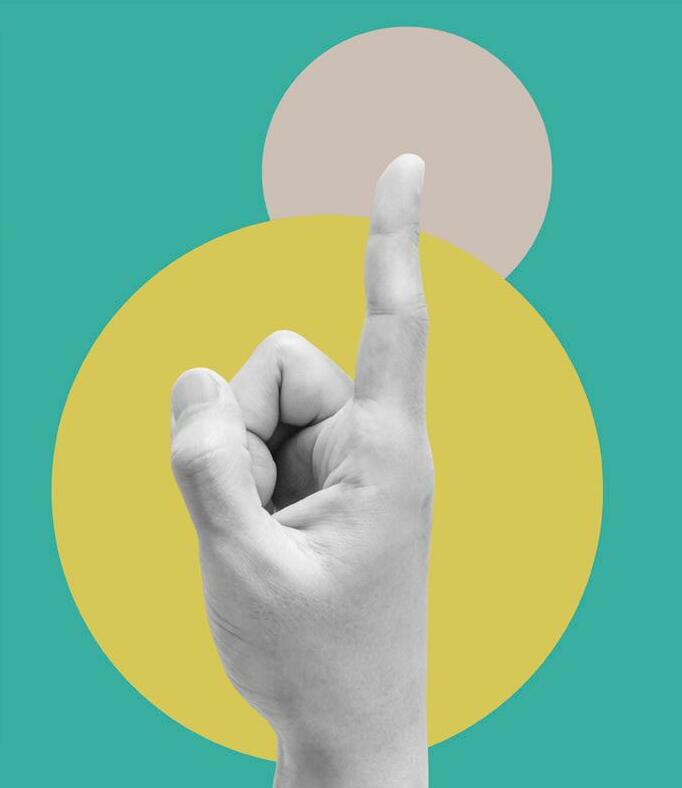
In the same manner, many faith-based teachings advise that you may dislike the actions of a person, but try not to dislike them, because deep down, they are the same as you, and you need to search for this common connection.
I have had times when I said no to a col league or boss, and the immediate reac tion was frosty, but this frustration soon melted away when we took on other work that was a lot more meaningful and in line with our goals as an organisation. If we had taken on the other task, which I did not believe was in line with our purpose, then we would not have had the capacity to deliver the work that was more in keep ing with our goals.
for and aWhat my pushback has also shown me is that other people become more mind ful of not wasting my time because they know what response they’re going to get. As a result, they work harder to set out the merits of what they bring to me because they know if it’s in line with our goals and purpose, then I will be 100 per cent behind it and the deliverables they receive will be of the highest quality available.
Here are a couple of techniques you can use to say no, without mentioning the word:
“Currently I am totally occupied on Project X, but once this is complete in 10 weeks’ time, I would be happy to get together to talk about your requirements.” If the task is urgent, they will find someone else to do it.
“I will need to check my availability on my calendar and can then drop you a note with some options.” This provides you with more time to think through how you will say no.
“I can take a look at this, but what task do you want me to deprioritise?” This is a useful response to someone more senior than you.
“I am maxed out at this time and would not be able to deliver a high-quality piece of work should I take this on.” This usually sends the asker to another door, as no one wants to compromise on quality.
“I am totally booked up at the moment, but you might want to try ‘X’ person.” If they need the task done, they will happily find another resource who can do it, and will be grateful to you for the referral. I have used this to refer business to others on numerous occasions. The person asking went away happy and the person taking on the work was grateful for the referral.
However, you say no, do not leave any ambiguity over it. Be clear you are pass ing on the opportunity. This is a lot more professional than leaving someone think ing you might say yes and trying to make it work. If the task is important to them, they will find another resource. If you stall from saying no, then it only becomes harder later on, and the other person will most likely hold a grudge against you for it.
Saying no when it is needed helps you maintain healthy boundaries at work; it also gives you time to complete things you’ve agreed to do
Rehan Khan, principal consultant
BT
novelist










































































































From geopolitical challenges and inflation to supply shortages and the resurgence of Covid-19, 2022 has been a year of uncertainty. To top it all, the threat of a global recession in the near future looms large as central banks continue to tighten monetary policies worldwide.
As a result, private wealth and a uent investors are looking to migrate to safer havens, which can protect their asset bases and enhance growth potential amid volatile times. According to the Henley Global Citizens Report, 2022 could witness the largest millionaire migration flows on record with as many as 125,000 millionaires having or preparing to relocate to shores that o er attractive business opportunities, competitive tax rates, and world class infrastructure.











The UAE is leading the race as a hub for global wealth and talent and is expected to attract 4,000 millionaires into its borders by the end of 2022 – the most of any country globally, as per the Henley Global Citizens Report. This projected increase, compared to 2019’s net inflow of 1,300, is set to be one of the largest on record. The influx of ultra-wealthy is aided by the emirate’s low tax regime, international business hub status, and finest healthcare and education system.

Moreover, the UAE’s successful track record of epidemic control and hosting
the World Expo despite Covid limitations speaks volumes of its infrastructural prowess. Recent changes to the immigration policies, including relaxed residency/citizenship requirements and changes to business ownership laws, are also tailored to attract private investors and foreign talent.

Historically, the UAE has always appealed to millionaires from Asia, particularly from India and China, and within the MENA region, from Saudi Arabia, Lebanon, Nigeria, and Egypt. However, the recent migration trends are also supported by geo-political events.
The Russia-Ukraine crisis has triggered a tsunami of private wealth leaving both these countries, with as many as 18,000 millionaires forecasted to migrate to safer
havens by the end of 2022. This represents almost 15 per cent of the millionaires in Russia and roughly 42 per cent in Ukraine as per the Henley Global Citizens.
On the other hand, traditional popular destinations for wealthy investors such as the UK and the US are losing their lustre due to the threat of increased taxes and political unpredictability manifested post Brexit vote in the UK and the likely return of a Republican House and Senate in the November 2022 mid-term elections in the US. Naturally, the migration of a uent investors will not only bring private wealth and capital but will also lead to establishment of new businesses that will attract global talent and provide employment opportunities to local professionals. Some of the early signs of this migration trend are already visible. For instance, the UAE’s financial wealth is expected to rise from $700bn in 2021 to $1tn in 2026, according to a report by Boston Consulting Group. This will generate immeasurable opportunities for our startups and SMEs to focus on innovation-centric industries.
Similarly, the number of new business licenses issued in Dubai expanded by 25 per cent in H1 2022 to reach 45,653 compared to the same period last year. Russians buyers have also invested heavily in Dubai real estate in Q1 2022, raising their position to fi th from the seventh place in the rating conducted by the brokerage firm Better Homes.
These numbers clearly reflect the UAE’s flourishing business ecosystem combined with supportive government policies and a new strategic vision.


The growing volume of businesses will be supported by the new industrial property laws and labour regulations while government-led initiatives such as ‘Make It in the Emirates’, Cybersecurity Strategy, Industry 4.0, etc. will continue to drive UAE’s dynamic entrepreneurial spirit.
In conclusion, global volatility presents a distinct opportunity for countries to capitalise on investors’ pressing need for alternative residency/citizenship-based investment solutions. Countries such as the UAE that fully embrace this migration trend through innovative financing solutions stand to reap the benefits in the coming years.
Shailesh Dash, founder and mentor, Dash Venture Labs
The UAE is leading the race as a hub for global wealth and talent and is expected to attract 4,000 millionaires into its borders this year















Net zero. Metaverse. Books trove. IPO galore.



If there was one word to describe the year 2022 for the UAE, it would be ‘futuristic’.


The UAE is no stranger to innovation and ambition. But this year was unprecedented in more ways than one. From announcing strategies to embracing the metaverse, implementing a new working week for federal government entities to inaugurating a Dhs1bn library and inking partnership agreements with key economies, the UAE o ered a glimpse of how it envisions the future, shaped by its strategic depth, tactical insights and an iron will.
“Economic growth has been robust this year, led by a strong rebound in tourism, construction and activity related to the Dubai World Expo, as well as higher oil production in line with the OPEC+ production agreements. Overall, GDP growth is projected to reach above 6 per cent in 2022, improving from 3.8 per cent in 2021,” said Ali Al-Eyd, who led an International Monetary Fund (IMF) sta team, which held discussions with UAE authorities for the 2022 Article IV Consultation from November 2-17.
Following a successful coordinated response to the Covid-19 pandemic, the UAE has demonstrated equivalent economic resilience, says James Dervin, head of strategy and performance improvement and co-head of Middle East, Alvarez & Marsal. “The region more broadly bucked global IPO trends, with several successful listings in the UAE. We also witnessed a series of significant legislative and social developments, including the change to the working week and employment visa rules, which will have increased the UAE’s attractiveness to both business and talent alike. It would be remiss not to also acknowledge the success and broader impact of Expo 2020.”
If the digitalisation orchestrated by the Covid-19 pandemic was tectonic, the year 2022 had disruptive plans of its own. As did the UAE. Consolidating its partnership with global tech players, Dubai, in the year’s first quarter, welcomed technology giant Meta’s new regional headquarters, from which it aims to serve markets across the Middle East and North Africa (MENA) region. The Mohammed bin Rashid Library too was inaugurated this year, which became the first in the Middle East region to deploy an artificial intelligence (AI) system as well as robots.
In July, Dubai launched its metaverse strategy to advance the virtual world’s economic contribution through R&D collaborations as well as to further its ambition to support over 40,000 virtual jobs by 2030. The new phase of the strategy was approved last month to empower the use of the metaverse and future technologies.
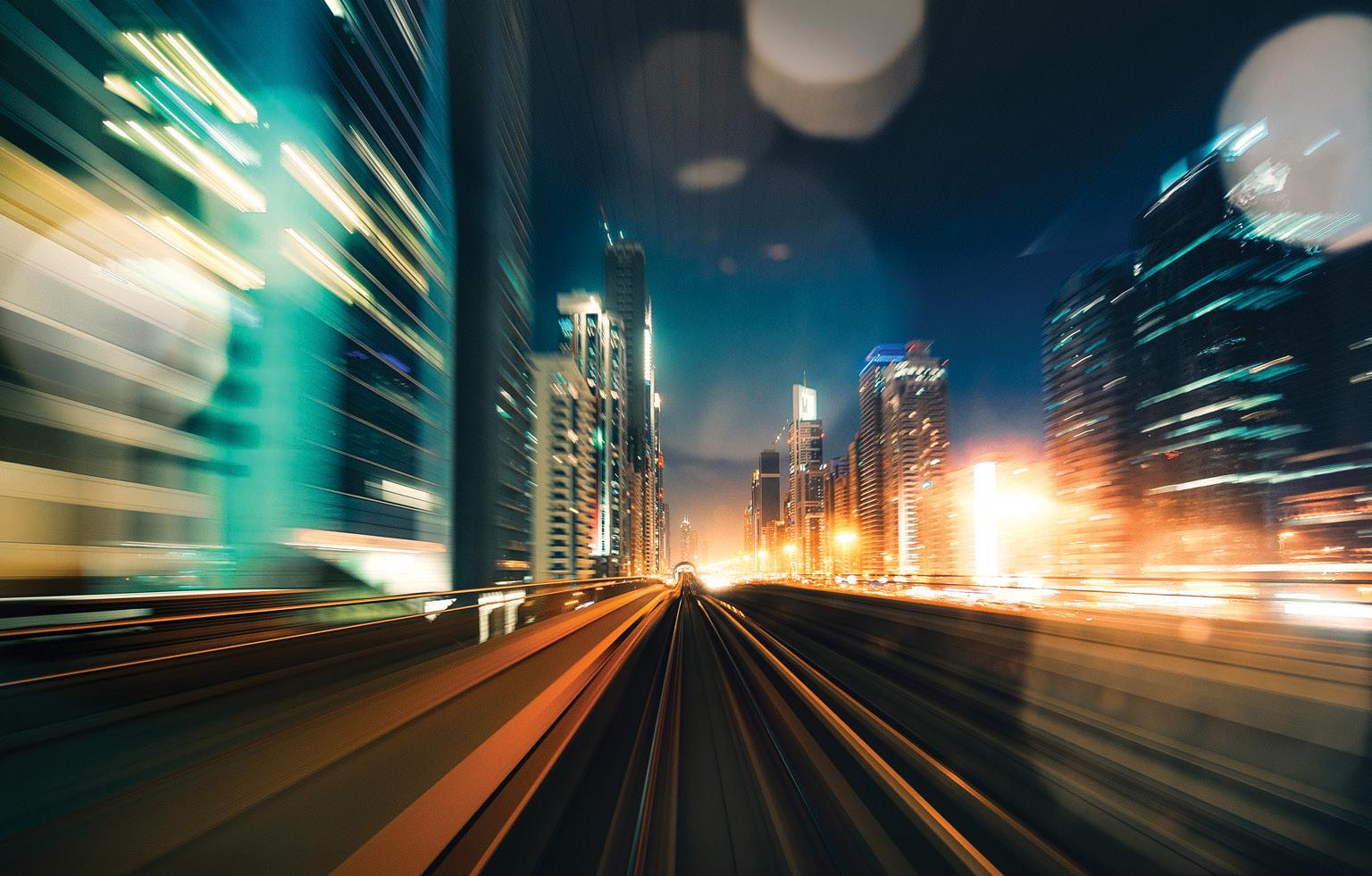
On the launch of the Dubai Metaverse Strategy, Omar bin Sultan Al Olama, Minister of State for Artificial Intelligence, Digital Economy and Remote Work Applications said that the metaverse would drive the UAE’s and Dubai’s e orts to provide

THIS YEAR THE COUNTRY MOURNED THE LOSS OF SHEIKH KHALIFA BIN ZAYED AL NAHYAN, THE UAE’S FORMER PRESIDENT, WHO PASSED AWAY ON MAY 13, AT AGE 73 ON MAY 14, SHEIKH MOHAMED BIN ZAYED AL NAHYAN WAS UNANIMOUSLY ELECTED BY THE FEDERAL SUPREME COUNCIL AS THE NEW UAE PRESIDENT
innovative solutions, positively impact people’s lives, and transform the city into one of the smartest hubs worldwide o ering new economic opportunities.
Several organisations drew inspiration, with Dubai Electricity and Water Authority (DEWA) becoming the first local government organisation to launch its platform on the metaverse, while telco e& also announced a so t launch of their virtual world.

Taking ‘innovation’ to the skies, Dubai hosted the world’s first public flight of the two-seater eVTOL (electric vertical take-o and landing) flying car, X2, in October, to leverage an era of intelligent mobility solutions. In the neighbouring emirate, Abu Dhabi Airports inked an MoU with French firm Groupe ADP to explore advanced air mobility in Abu Dhabi to sustainably transport passengers and cargo.

The year started on a strong note for the local telecommunications industry, with the launch of a new brand identity – e& - for telecom giant Etisalat Group. The company’s strategy aims to catalyse growth through a business model that represents key pillars, such as e& life which focuses on delivering digital experiences to customers through smart connectivity platforms; e& enterprise which will propel the digital transformation of governments, corporates and enterprises; and e& capital which will drive the group’s growth. Meanwhile, the company’s rebranded telecom arm – etisalat by e& – conducted its first 6GHz test in the MENA region, opening possibilities for next-generation technologies. Telecom major du also partnered with Abu Dhabi’s Masdar City to build a 5G centre of excellence.
The year 2022 was a banner year for listings in the country, with Dubai and Abu Dhabi bourses being part of an IPO-rush that emerged as a bright spot in an otherwise grim global market.

DEWA’s IPO on the Dubai Financial Market (DFM) in April, that helped raise $6.1bn against an order book of almost $86bn, was the biggest listing across the Europe, Middle East and Africa (EMEA) region since Saudi Aramco’s 2019 o ering. The listing was followed by Dubai’s business districts operator Tecom Group’s IPO, which raked in $460m. Dubai toll operator Salik, which garnered over $1bn from its share sale, became the emirate’s third listing for the year and the largest MENA IPO during Q3, according to EY. It was followed by Emirates Central Cooling Systems Corporation (Empower), which amassed $724m from listing a 20 per cent stake on DFM. The $204m IPO of school operator Taaleem Holdings last month capped a healthy stream of listings in Dubai.


Petrochemicals firm Borouge also raised total proceeds of over $2bn from listing a 10 per cent stake on the Abu Dhabi Securities Exchange (ADX) this year, making it the bourse’s largest ever IPO. Additionally, AD Ports Group, Burjeel Holdings and G42-owned Bayanat also listed on the bourse.

The UAE announced the National Net Zero by 2050 Pathway at the COP27 summit this year, which outlined the timeframe and ways of implementing the country’s initiative to achieve net-zero emissions by 2050.


Meanwhile, the country has continued with its e orts to increase the share of clean energy in its overall power mix. Unit 2 of the Barakah nuclear energy plant started commercial operations in March, while the plant’s third unit was also connected to the UAE’s transmission grid this year. When the four units are commercially operational, the plant will prevent over 22.4 million tonnes of carbon emissions each year.
The country also bid farewell to Expo 2020 Dubai, which concluded on March 31. Building on its legacy, the exhibition site was morphed into a clean, tech-enabled city – Expo City Dubai – which o cially opened its doors in October. The car-free destination, which has retained several of Expo 2020’s attractions, is beckoning guests to a gamut of educational and entertainment o erings, as well as welcoming businesses to set up shop.
The UAE has continued to prioritise the tourism sector to position itself as a hub of diverse experiences and unique destinations. The year 2022, however, raised the bar considerably high, with the country launching its national tourism strategy, aiming to welcome 40 million hotel guests by the year 2031. The strategy, which includes 25 initiatives and policies, will target raising the tourism sector’s contribution to GDP to Dhs450bn ($122.5bn) in 2031.

With the world opening up to travel in the wake of the Covid-19 pandemic, local airlines swung into action this year, launching new routes, inking new agreements and posting promising bottom lines. Dubai-based Emirates Group recorded a 2022-2023 half-year profit of $1.2bn, scaling from a $1.6bn loss posted during the same period last year. The airline carried 20 million passengers between April 1 and September 30, up 228 per cent from a year-earlier period, while Dubai Airports ramped up its annual forecast for passenger tra c at Dubai International (DXB) to 64.3 million.
Meanwhile, Abu-Dhabi based Etihad Airways also posted $296m in core operating profit for the first half of 2022, swinging into the green zone from a $392m loss recorded during H1 2021. The carrier’s first flight using sustainable aviation fuel took o from Tokyo in October.





If this year’s initiatives undertaken by the UAE are anything to go by, the next year is expected to be promising at the very least. From playing host to the COP28 summit to introducing federal corporate tax on business profits next year, the country is looking to push the boundaries in innovation and development. Going beyond the imminent future, the recently launched ‘We The UAE 2031’ plan will help shape the country’s future for the next decade.
However, the UAE’s e orts to develop a technology-driven, integrated and sustainable future is not a case of ambition gone unchecked. It is simply a country’s vision to sculpt a legacy, that would, generations hence, speak to its drive of growth, and of possibility.


In short, a legacy worth investing in.










Saudi Arabia is at an inflection point. Helmed by a young leadership, with an astute focus on key industries and initiatives, the kingdom is leaving no stone unturned to help curate a diverse and integrated future, as well as position itself as a global hub.
Saudi Arabia’s vision for the next decade not only includes a roadmap and a timeframe for its economic transformation but also the depth of its recalibration. Among prime industries that form part of the country’s bailiwick, is real estate. Mega projects, sprawling hotels, smart cities, regenerative plans and a strong will from the leadership are helping redefine living for local residents and positioning the country as a top tourism destination.
Prime among the real estate spectrum is residential development, which is a focal point for the country and has secured a spot in its Vision 2030. At the forefront of this campaign is the National Housing Company (NHC), a Riyadhheadquartered real estate development giant, which seeks to provide a gamut of affordable housing options via urban communities to meet the aspirations of the current and future generations. Operating as the investment arm of Saudi Arabia’s Ministry of Municipal, Rural Affairs and Housing, the company has contributed

to the advancement of the country’s real estate sector by increasing housing supply, enhancing capabilities of property developers and service providers, and providing investment options to owners.
“We play an active role in stimulating the housing and real estate system and achieving a balance with the rest of the sectors, notably to attain the goals of the housing programme and overall vision,” explains Mohammed Bin Saleh Albuty, NHC’s chief executive officer.
The National Housing Company operates with three subsidiaries, covering the service spectrum of the real estate industry – the National Housing Services Company provides housing services; the National Asset Manage ment Company supports asset management and facilities; and the National Financing Services Company operates as a central platform for managing finance for the Saudi
Real Estate Refinance Company, which facilitates access to sustainable financing solutions for homebuyers in the country.
More notably, NHC has been pivotal in bolstering the manufacturing and use of local materials in part nership with the private sector stakeholders, including real estate developers, contracting companies, materi als supply companies, and others.
“The percentage of local materials exceeds 90 per cent of the products used in project development. Cur rently, we have over 163 projects under construction, alongside more than 160 developers and real estate contractors. This will lead to an addition of more than 123,000 housing units, with value exceeding SAR96bn across 19 cities. Over 14,000 units have already been delivered to customers,” adds Albuty.

Saudi Arabia has launched several initiatives to revamp its residential real estate landscape. In 2018, the kingdom


THE PERCENTAGE OF LOCAL MATERIALS EXCEEDS 90 PER CENT OF THE PRODUCTS USED IN PROJECT DEVELOPMENT
WE PLAY AN ACTIVE ROLE IN STIMULATING THE HOUSING AND REAL ESTATE SYSTEM AND ACHIEVING A BALANCE WITH THE REST OF THE SECTORS, NOTABLY TO ATTAIN THE GOALS OF THE NATIONAL VISION/HOUSING PROGRAMME”
launched the housing programme to enable Saudi families to own suitable housing, thus enhancing their living conditions, increasing inventory, developing local content and creating additional employment opportunities.
According to The Housing Program Delivery Plan (2021-2025), the programme’s first phase (2018-2020) revamped the governance, delivery and financial mechanisms of the residential housing sector. Expanding access to finances, improving sector regulations, introducing technologies and practices, and increasing housing unit delivery drew success with home ownership rising considerably. The programme’s 2025 Strategy evolves its strategic focus ‘from rapidly accelerating ownership to steadily improving market a ordability, sector maturity and housing access,’ the plan stated.
The collective e orts have led to an increase in demand for home ownership. “One of [the housing programme’s] most prominent goals was to raise the percentage of home ownership from 47 per cent before its launch to 62 per cent by 2022. This is what happened during the current year as a result of integration
between all relevant parties under the programme, with NHC playing a pivotal role,” notes Albuty.
The National Housing Company has also inked several partnerships with stakeholders for joint collaboration to advance the sector. It recently penned a pact worth over $10bn with the Ministry of Municipal, Rural A airs and Housing to develop infrastructure across multiple cities. “The agreement aims to provide more than 150,000 housing units of varying sizes and designs, covering 11 cities across Saudi Arabia, on an area of more than 90 million square metres. Of this, approximately 54 million square metres will be allocated to green and open spaces, public utilities, road networks and public transport,” says Albuty.
NHC also signed a Memorandum of Understanding (MoU) with Diriyah Gate Development Authority (DGDA) earlier this year to bolster integration between the two entities and o er additional design options to NHC clients within the authority’s jurisdiction.

The company has also unveiled several projects in the Al-Madinah province. “National Housing Company continues to develop the real estate sector in Al-Madinah Province, where we recently launched the largest housing projects, suppling over 20,000 housing units spread over an area of more than 9.7 million square metres to accommodate in excess of 100,000 people, across the communities of Al-Mukaiman, Al-Ghoroub, the suburb of Al-Dar and the community of Loulou’a Home,” explains Albuty.
“We also signed ten agreements worth over SAR9bn to develop the Al-Mukaiman community and the suburb of Al Dar. This will be followed by an investment of over SAR8bn in the sunset community and new projects,” he adds.
WE ALSO SIGNED TEN AGREEMENTS WORTH OVER SAR9 bn TO DEVELOP THE ALMUKAIMAN COMMUNITY AND THE SUBURB OF AL DAR
But offering housing options isn’t the only mandate for the real estate giant. It ultimately aims to raise the standard of living for people across the country and is targeting that goal through its projects. “NHC has applied quality-of-life standards across all its projects, to achieve sustainability and wellbeing for its beneficiaries,” notes Albuty. “In NHC, we adopt the modern lifestyle [concept] that aims to achieve the global trend to humanise cities, improve the urban
landscape, and create integrated residential suburbs in which residents do not depend on car traffic alone, but have access to daily basic services and facilities in less than five minutes on foot, and to central services and entertainment within a space of 10 minutes,” says Albuty.
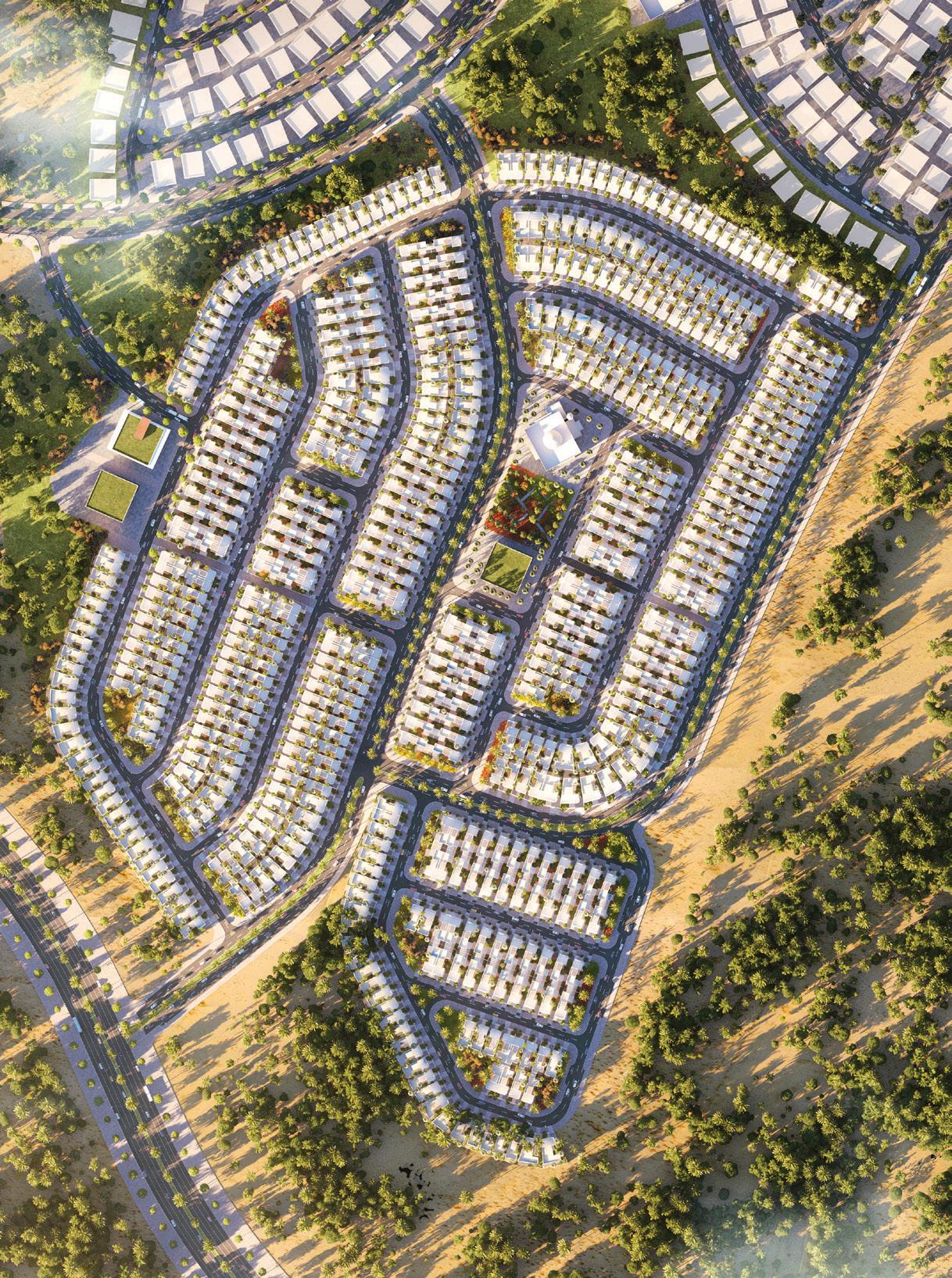
“Additionally, we have adopted a set of governing rules in our projects, such as diversifying modern designs and increasing green spaces so that the urban community is a healthy place committed to environmental principles,” adds Albuty.
With joint collaborations and mas sive projects, the Saudi residential real estate market is set to acceler ate. The country’s population stood at 34.1 million by mid-year of 2021, of which over 57 per cent were under the age of 35. Meanwhile, Saudi nationals form a formida ble consumer force, making up 63.6 per cent of the total popula tion last year.
NHC, in line with national pri orities, also aims to add to the property inventory and facilitate its growth. “Our main priorities going forward include increasing the real estate supply and ready ing 300,000 housing units for sale in 2025; building smart residential communities and suburbs that provide quality of life to ensure the wellbeing of residents and the sustain ability of neighbourhood facilities; and contributing to raise the transparency of the real estate market and facilitating operations through initiatives and prod ucts,” shares Albuty.
The kingdom is resetting its real estate landscape brick by brick. And from the looks of it, the future looks promising.
NATIONAL HOUSING CONTINUES TO DEVELOP THE REAL ESTATE SECTOR IN AL-MADINAH PROVINCE, WHERE WE RECENTLY LAUNCHED THE LARGEST HOUSING PROJECTS, SUPPLING OVER 20,000 HOUSING UNITS SPREAD OVER AN AREA OF MORE THAN 9.7 MILLION SQUARE METRES TO ACCOMMODATE IN EXCESS OF 100,000 PEOPLE”
GOING FORWARD INCLUDE INCREASING THE REAL ESTATE SUPPLY AND READYING 300,000 HOUSING UNITS FOR SALE IN 2025



Of the rental contracts, 89.30 per cent were annual contracts while 10.70 per cent were non-annual leases. Commercial leases comprised 28.46 per cent of the total while 70.35 per cent were residential leases
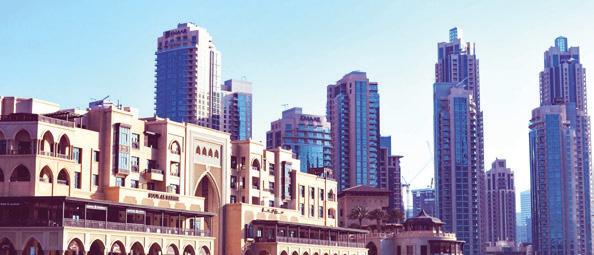


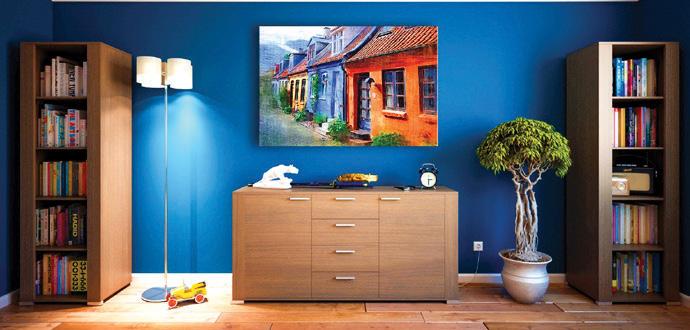


Business Bay 2516
Arjan 889
Dubai Hills Estate 831
Jumeirah Village Circle 823


The Lagoons 740
Mohammed Bin Rashid City 716
Downtown Dubai 657 Dubai Harbour 484 Palm Jumeirah 483 Meydan 428
Dubai South
(Dubai World Central) 440 Mudon 417 The Valley 311 Rukan 162 Villanova 114

Dubai Investments Park 108 Arabian Ranches 3 93
Mohammed Bin Rashid City 68 Town Square 68 Tilal Al Ghaf 47
Business Bay 935
Jumeirah Village Circle 715 Dubai Marina 709
Downtown Dubai 571 International City 497 Palm Jumeirah 374
Jumeirah Lakes Towers 341 Dubai Sports City 251
Dubai Silicon Oasis 242
Dubai Hills Estate 232
Damac Hills 2 (Akoya) 177 Mirdif 132
Al Furjan 126 The Springs 112 Villanova 110
Dubai Hills Estate 107 Arabian Ranches 95 Jumeirah Park 88 Arabian Ranches 2 82 Reem 70
Presently, Vaidhyanathan is the group CEO at the UAEheadquartered Ghassan Aboud Group (GAG), driving growth across a diverse portfolio of businesses that include automotive, retail, food, hospitality, logistics, healthcare and eB2B digital platforms. The group is well positioned for robust growth with several ongoing pro jects within its core sectors.
Vaidhyanathan played a pivotal role the conceptualisa tion of the group’s joint ventures with the AD Ports Group to develop Abu Dhabi Food Hub – KEZAD and Global Auto Hub – Abu Dhabi as public private partnership projects. He also spearheads the group’s digital transformation initia tives that led to the launch of digital platforms and other upcoming transformative projects.
The automotive business at the Ghassan Aboud Group is an unmatched platform that includes aggregation of a comprehensive range of automotive products and reach ing them to more than 100 countries. The hospitality brand Crystalbrook Collection is reputed for sustainability and manages a A$1bn portfolio of wholly owned five-star prop erties in Australia.
Suresh Vaidhyanathan is an accomplished business leader, having played key strategic roles with the region’s foremost business conglomerates for more than 25 years. His experience spans across multiple business sectors and countries in Middle East, Asia and Africa.

Vaidhyanathan is a qualified chartered accountant and an alumnus of the Digital Business Transformation programme from the IMD Business School. He has completed several management programmes at Harvard, Wharton, MIT Sloan (AI & Blockchain), Chi cago Booth School and INSEAD.
In 2012, Suresh qualified as a NACD Board Leadership Fellow (National Association of Corporate Directors, USA). In addition, he is a certified board director with the Institute of Directors, Dubai (Hawakamah).
Encouraged by positive consumer response, the group’s premium grocery retail brand - Grandiose Supermarket, is undergoing a rapid expansion and is set to reach 50 stores by end 2023. The group’s food distribution and catering companies are also set to expand their operations, deliver ing exacting standards of nutrition and healthy products. Gallega Global Logistics provides innovative solutions across a diverse customer base including fulfilment opera tions for digital platforms. The disruptive digital platforms BuyGro (FMCG) and BuyParts24 (auto spare parts) have achieved significant traction in the addressable market within a short period since the launch.
The group CEO’s values are centred around integrity, innovation and prospering in part nership with the community. The Ghassan Aboud Group seeks to engage in businesses that create significant socio-economic impact and promote sustainability. The motto is very simple yet inspiring, “Building a better future, together”.
THE GHASSAN ABOUD GROUP SEEKS TO ENGAGE IN BUSINESSES THAT CREATE SIGNIFICANT SOCIOECONOMIC IMPACT AND PROMOTE SUSTAINABILITY
Othman Aljeda joined Aramex in 1994 and fulfilled various leadership roles to strengthen the business across several markets. From 2007 until 2017, Aljeda was instrumental in setting up Aramex’s first regional office in Asia and spearheading its regional expansion plans.
In 2017, he was named the company’s regional CEO for Europe, North America, and Asia. In addition to his regional responsibilities, Aljeda took on the role of interim chief operating o cer for six months in 2020 and was appointed CEO a year later.
Under his aegis, Aramex completed the acquisition of cross-border e-commerce enabling platform, Access USA Shipping (MyUS) in October this year, for an all-cash purchase price of approximately $265m, making it the company’s largest acquisition.
ARAMEX REPORTED $1.19BN IN REVENUE FOR THE FIRST NINE MONTHS OF 2022, WHILE ITS NET PROFIT FROM CONTINUING OPERATIONS REACHED $34.8M
The firm recently completed its drone delivery testing in Oman, with plans to broaden the testing across the Middle East region, and in other core operating markets. Meanwhile, Aramex reported $1.19bn in revenue for the first nine months of 2022, while its net profit from continuing operations reached $34.8m. It plans to expand its network to serve more than 550 cities by 2023.
Hosam Arab, the CEO of payments and shopping app Tabby, is a distinguished name across the UAE’s entrepreneurial ecosystem. He co-founded online fashion platform Namshi in 2011, which was fully acquired by retail giant Emaar Malls in 2019. The same year, Arab founded Tabby, which has since expanded regionally and is active in Saudi Arabia, the UAE, Egypt, and Kuwait.


In August, Tabby secured $150m in debt financing from Atalaya Capital Management and Partners for Growth, which followed a $54m Series B extension earlier this year, scaling the total funding raised to over $275m. In September, Tabby also partnered with payments facilitator Paymob, to create a buy-now-pay-later solution for both in-store and online retailers in Egypt.
Leading from the front, Arab has steered the company’s momentum, reporting a 10x growth in revenue, 8x in active customers and 3x in active retailer partners in the first half of 2022, compared to the same period last year. Meanwhile, over 8,000 global brands and small businesses use Tabby, with more than two million active users in its network.
IN AUGUST, TABBY SECURED $150M IN DEBT FINANCING FROM ATALAYA CAPITAL MANAGEMENT AND PARTNERS FOR GROWTH, WHICH FOLLOWED A $54M SERIES B EXTENSION EARLIER THIS YEAR
When Harish Prithvi, COO of AIX Invest ment Group, first came to the UAE in 2012, a mentor told him: “Anyone can aspire and become anybody here”. Prithvi often says that he didn’t truly understand what it meant back then. But after 10 years in this country, he agrees.
According to Prithvi, the UAE breathes entrepreneur ship, not just for business owners but also for employees who will often find that organisations here encourage an entrepreneurial mindset.
Prithvi started his career in IT-enabled services at Dell 19 years ago in India. Having learned the ropes of the busi ness, he then moved on to TCS (an Indian IT major owned by the Tata conglomerate), where an insightful mentor recognised his skills of being a people’s person. In TCS, he joined the transition team, where he was entrusted with customer engagement responsibilities, interacting with clients, understanding their concerns and creating tailored, cost-effective solutions.
In his five years with TCS, Prithvi had the opportunity to meet clients from all verticals and geogra phies, which led him to enter the consult ing space With this, he joined KPMG as a management con sultant – Strategy and Advisory, where he worked for three years.
With 11 years into his professional career, Prithvi spent a month in Dubai and zeroed in on the city. Looking back, he feels that he came to Dubai to “learn the city”. This is when he also took a sabbatical to upskill and join the Hult International Business School to pursue his execu tive MBA (EMBA).
After his EMBA, he and his two friends set up a financial brokerage company that married finance with real estate. He played a key role in shaping the organisational struc ture of the companies such as CEM Business Solutions, Advance Financial Solutions and Home Bridge Finance.
Prithvi first met the founder of AIX Investment Group as a potential client himself. However, his differential thinking, fundamental understanding of structured investment products and logical reasoning led him to join the company as an external consultant. In 2019, he joined AIX as director – Strategy and was elevated to the role of a chief operating officer of the group in May 2022.
Prithvi opines that three sectors are slated to see maximum growth in the UAE – real estate, tourism and finance. For creating a growing business in the UAE, he believes that it should contain at least two out of these three sectors in its core offering.

Prithvi says that a true leader can project authority without intimidation and believes in making his peers feel at ease while orienting them into their new roles so that, in the future, all the employees can function independently.
Prithvi’s idol is Ratan Tata, the Indian industrialist and former chairman of Tata Sons, a man who remains humble and down-to-earth despite his lofty achievements and great success.
A TRUE LEADER CAN PROJECT AUTHORITY WITHOUT INTIMIDATION AND BELIEVES IN MAKING HIS PEERS FEEL AT EASE WHILE ORIENTING THEM INTO THEIR NEW ROLES SO THAT, IN THE FUTURE, ALL THE EMPLOYEES CAN FUNCTION INDEPENDENTLY”VED CEO - 6thStreet.com



Dharmin Ved has built a successful career as the CEO of 6thStreet.com, an omnichannel retailer of high-street fashion and beauty brands across the GCC. A chartered accountant from the UK, Ved landed his first job at Ernst & Young in London. He was also appointed as the CEO of LM Exchange, a role he continues to fulfill even today.
Ved made his debut in the fashion retail industry by taking on the role of managing director of the Apparel Group in Russia. During this time, he operated three brands and opened 30 stores over four years.

In November 2016, he launched 6thStreet.com, which over the years, has rapidly grown to become one of the top e-commerce destinations in the region. Ved developed a strong vision of embracing technology and of seamlessly merging the physical and online shopping experience.
He orchestrated the formation of Dubai’s first ‘phygital’ store of 6thStreet at Dubai Hills mall. The ‘phygital store’ holds seven times the inventory of a regular store, stocking almost every brand the 6thStreet.com app has available in the UAE, such as Birkenstock, Calvin Klein, Tommy Hilfiger, Crocs, Levi’s, Skechers, Adidas, Nike, Dune London, Aldo, Toms and more.
 ELIE SKAF co-founder and CEO - Right Farm
ELIE SKAF co-founder and CEO - Right Farm
Born in Jezzine, Lebanon and raised in Abu Dhabi, Elie Skaf co-founded Right Farm in 2021. In his role, he is responsible for managing stakeholders and spearheading the company’s business development e orts with a particular focus on fundraising.

Prioritising internal strategy and growth to ensure a positive and e ective working environment, Skaf is dedicated to solving current global food security challenges. To achieve net-zero and sustainable development goals, as well as ensuring food security, Skaf believes supply chain optimisation of the food value chain is crucial to ensuring a restorative and regenerative approach to our economies. He is also looking to lead the organisation towards sustainable goals and expanding the company’s verticals across the Middle East, North Africa, Pakistan, Turkey (MENAPT) region.
EARLIER THIS YEAR, RIGHT FARM RAISED $2.8M IN SEED FUNDING LED BY DISRUPTAD, ADQ’S VENTURE PLATFORM AND ENHANCE VENTURE

Earlier this year, Right Farm raised $2.8m in seed funding led by DisruptAD, ADQ’s venture platform and Enhance Venture, the venture studio for the MENAPT region.
Skaf’s previous experience includes demand planning and pricing at AstraZeneca, management consulting at PWC; head of business development and partnerships for Careem; and business development for Surkus. In addition, he helped build e-commerce venture, Loop Contacts, where he now sits as a board member.






From the co-creators of award-winning tech event LEAP, we introduce Tahaluf, a joint venture between Informa PLC, and the SAFCSP.










Tahaluf’s mission is to transform Saudi Arabia into a global meeting hub and bring world-class events to the Kingdom.

Gulf Business hailed the region’s trailblazers at its award ceremonies held in November to draw the curtains on what has been a remarkable year. Luminaries across the region’s business ecosystem were celebrated at the 10th edition of the Gulf Business Awards, while the second edition of the GB Tech Awards honoured stalwarts and companies for their contributions to the technology landscape


If 2021 was a year of transformation, 2022 has been the year of acceleration. Two years a ter the pandemic brought the world to a near halt, the UAE and the Gulf region have bounced back – with speed, resilience and gains, owing to the windfall from higher oil prices – and the public sector driving the non-oil economy. Despite economic headwinds, businesses and industries in the region have shown robust growth, setting an example for economies all over the world and the pace for the year ahead.

It is to recognise the performance of these exemplary companies and the inspiring leaders who enabled this growth that G hosted the 10th edition of the Gulf Business Awards. The gala ceremony was held at Central Park Towers, DIFC, Dubai, on Wednesday,

November 23. More than 250 of the region’s top business leaders attended the ceremony, which featured 30 trophies being awarded to notable leaders and companies across a wide range of sectors, including investment, tourism and hospitality, transport and logistics, real estate, banking, healthcare and retail among others.

Furthermore, trophies were also given out to individuals and companies across five categories, including Sustainability Company of the Year, SME of the Year, Business Disruptor of the Year, Female Leader of the Year and Marketer of the Year.
The coveted Lifetime Achievement accolade was presented to Isobel Abulhoul OBE, CEO and trustee of Emirates Literature Foundation and co-founder of Magrudy’s, who has consistently demonstrated a strong
commitment to fostering literacy and instilling a culture of reading throughout the region.
In his opening address at the event, Ian Fairservice, managing partner and group editor-in-chief of Motivate Media Group congratulated the regional business community on their success and initiative. He said: “Over the last 26 years, Gulf Business has been the leading voice for the region’s business community and celebrating the 10th anniversary of the awards is an important milestone for us. The Gulf Business Awards proudly
celebrate the achievements of the GCC’s business leaders, and companies who have enabled the transformation of the region – spearheading innovation, sustainability and growth.”
Award winners were chosen by a judging panel of respected industry luminaries, including George Hojeige, CEO –VirtuGroup, Helen Barrett, deputy chair – British Business Group Dubai and Northern Emirates, and partner – CBD Corporate Services, Ian Fairservice and Andrew Wingrove, group director, Motivate Media Group.

Books have the power to enlighten, inspire and enter tain, and they have been Isobel Abulhoul’s passion and purpose all her life.
Abulhoul has been a fervent advo cate of literacy and continues to support the cause of education in the UAE since she arrived in 1968 from the UK, to make Dubai her home. In 1975, Cambridge-born and educated Abulhoul co-founded Magrudy’s, a bookshop chain, which now has over 15 stores across the country.
In addition to setting up Magrudy’s, Abulhoul actively set about publish ing children’s books in Arabic and English. In 2008, she founded the
Emirates Airline Festival of Litera ture. The festival, which held its 14th edition this year, is now an important event in the city’s social calendar. A total of 181 authors across 47 nation alities took the stage this year – a testament to Abulhoul’s tireless efforts to establish the festival as the Middle East’s largest award-winning celebration of the written and spoken word.
In 2013, Sheikh Mohammed Bin Rashid Al Maktoum, Vice Presi dent and Prime Minister of the UAE and Ruler of Dubai, who is also the festival’s patron, issued a decree establishing the Emirates Literature Foundation, naming our lifetime
achievement winner as one of the trustees on the board; she also holds the position of CEO.
No stranger to accolades, Abul houl has received several awards over the years such as ‘Cultural Per sonality’ of the Year from Dr Sheikh Sultan Bin Mohammed Al Qasimi, the Ruler of Sharjah in 2010; the prestigious OBE conferred by the late Queen Elizabeth II of Great Brit ain in 2012; and the Pioneer’s Award in 2016 from Sheikh Mohammed.
Gulf Business is proud to recognise our Lifetime Achievement winner’s significant efforts in transforming the literary and cultural landscape of the UAE.

























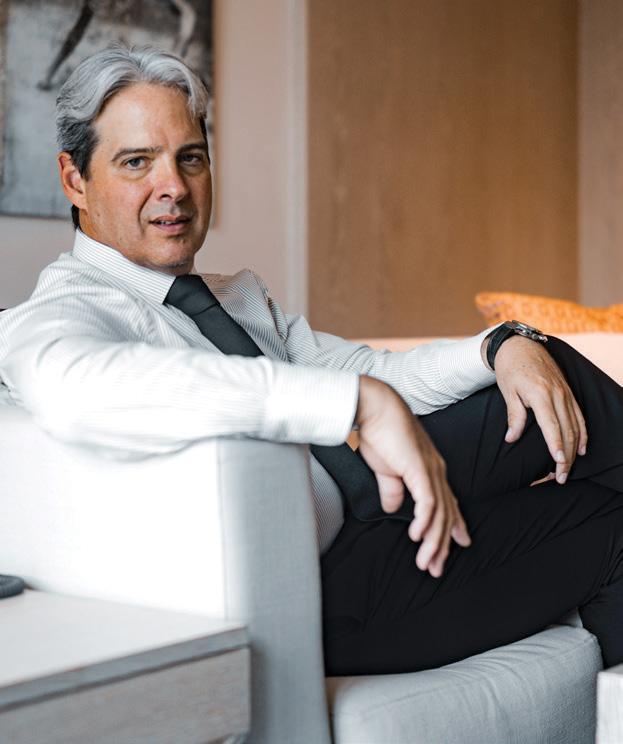











Small and medium business enterprises (SMEs) are the backbone of the UAE’s economy. They employ over 86 per cent of the labour force in the private sector and contribute more than 60 per cent of the GDP.

These businesses are supported by the government’s visionary leadership as well as funded by public and private organisations, which has provided them with significant opportunities to disrupt a wide range of sectors including finance, technology, healthcare and mobility. This year, Gulf Business in association with Century Financial, one of the oldest financial institutions introduced the Golden Frame SME Awards to recognise the leaders across the small and medium enterprises who championed innovation, business strategy, product delivery, sustainability and customer service, among others.































THE SECOND EDITION OF THE GB TECH AWARDS RECOGNISED THE ACHIEVEMENTS OF REGIONAL TECHNOLOGY FIRMS














The GB Tech Awards 2022, one of the region’s most innovative technology events, hosted 26 outstanding technologists to celebrate their extraordinary contributions and impact on the regional technology industry.

In its second edition, GB Tech Awards honoured and celebrated the achievements of regional technology firms that have significantly contributed to enhancing customer experience and their day-to-day operational processes through technology.



This year, over 75 nominees made it to the final stages of the competition, following a detailed submission and judging process that took place during this year’s competition. All the awards finalists represented a wide
range of tech segments, spanning cloud services, artificial intelligence, cloud security, fintech, consumer tech, digital transformation and women in tech, among others.






An independent panel of experienced judges with a wealth of knowledge and experience in di erent technology areas within the regional and international market carefully selected the winners from various categories.
Ian Fairservice, managing partner and group editor-inchief of Motivate Media Group said, “We are privileged to be hosting the second edition of the GB Tech Awards where we honour and celebrate the trailblazing leaders and companies that are shaping the future. We extend our congratulations to each of the winners.”


























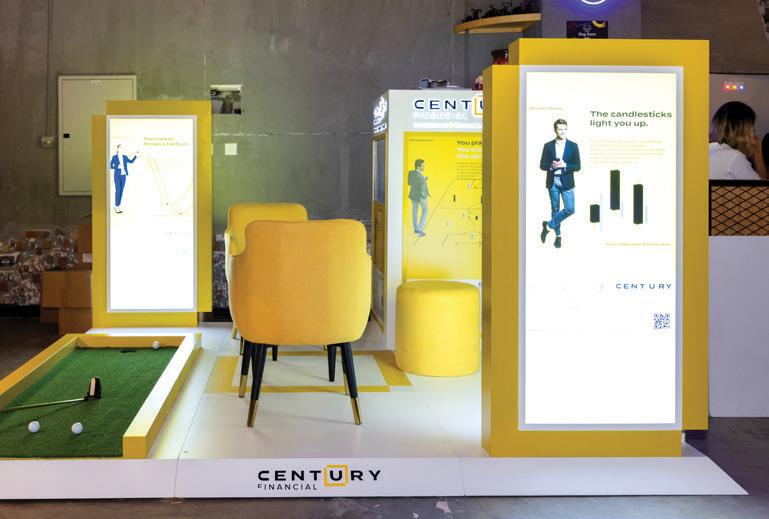
























Hublot continues to challenge the norm, innovating with materials, shapes and movements, as it continues to win fans for its unique interpretation of watchmaking p.60

“Historically, cooking and eating food together, has always united people across cultures and backgrounds. It’s a catalyst for human interaction and engagement”
Dalia Lachine, co-founder and CEO, BreakBread
TUMI | McLaren Velocity backpack

Constructed from CX6 carbon fibre, the collection’s latest backpack features a padded laptop sleeve, two elastic-open side pockets, and a back pocket with a magnetic snap and built-in type-C USB port

by LVMH. This marked the beginning of vertical integration, with the opening of a new production site in 2009, in Nyon, Switzerland, and it has progressively been extended over the years. It has given the brand the capacity to manufacture its own chronograph movement, with an integrated column wheel on the dial side, known as Unico.
One of our biggest achievements was the launch of our Unico in-house movements in the King Power Unico collection back in 2010. The brand has continued to invest in research and development with its R&D division and is renowned for its high-tech developments and materials such the all-sapphire case, which has been widely popularised by Hublot, as well its use of titanium, carbon and ceramic. We also developed a new alloy of 24K gold and ceramic that has be impossible to scratch, revealing “Magic Gold” to the public in 2011.
Meanwhile, in 2015, we set up a second facility, and this important step underlined not only Hublot’s success, but also our evolution towards the status of a fullyfledged, future-oriented manufacture, with many different technologies and skills, particularly with regard to materials. On this subject, I would say that the creation of our red ceramic, presented in 2018, was a memorable step, as we demonstrated that our R&D department was capable of designing unique materials that no one had managed to create so far. In 2022, Hublot revealed its first square watch, with the new Square Bang Unico collection. The manufacture has drawn on its extensive expertise to meet this horological challenge where rather than conceal the round movement, Hublot decided to completely reveal the inner workings.







Hublot’s first launch back in 1980 broke new ground in watchmaking when it paired gold, a precious metal, with rubber. In 2004, Jean-Claude Biver was appointed CEO of the brand; he took the original concept of combining materials even further, exemplifying Hublot’s “Art of Fusion”.
Big Bang, the brand’s flagship collection, took its cue from the timepiece launched in 1980. It immediately went on to claim the ‘Best Design’ prize at the Grand Prix d’Horlogerie de Genève. Soon a ter it was joined by the King Power collection and, later, the Classic Fusion range as well as the Spirit of Big Bang collection.
In 2008, a ter almost 30 years as an independent brand, Hublot was taken over



As I mentioned, Hublot was the first brand to have dared to combine gold and rubber in the same watch, thus mastering the ‘Art of Fusion’. The fusion of past and present in a futuristic watch; of traditional, modern and pioneering materials; and cra tsmanship of watchmaking and the power of an innovative design identity. We always draw inspiration from our partnerships especially on the artistic level. For example, our timepieces have

How does Hublot blend style and design with the mechanics of time-keeping to create one-of-a-kind watches?
How has Hublot evolved since its launch in 1980 and what are some of the key milestones of its journey so far?
TEDESCHI, HUBLOT’S REGIONAL DIRECTOR FOR LATIN AMERICA AND THE CARIBBEAN, MIDDLE EAST AND AFRICA, TELLS NEESHA SALIAN ABOUT THE BRAND’S UNIQUE APPROACH TO WATCHMAKING AND WHY ITS WATCHES CONSISTENTLY BREAK THE MOULD TIME AND AGAIN
been offered as a canvas for collaborators to infuse their creativity, demonstrated in our collaborations with renowned artists Takashi Murakami, Richard Orlinski and Shepard Fairey, and designer Samuel Ross. When we work with them on a timepiece, it is not just simple artwork on the dial, but a complete redesign of the watch to fuse the artist’s and brand’s DNA, resulting in a unique watch.
Tell us about your customer profile and how the brand reflects their aspirations and expectations.
Hublot’s customer base remains young and composed of successful individuals. These customers do not necessarily have

extensive experience or exposure to the nuances associated with traditional watch making, but they are sensitive to design and our message. Since Hublot cannot rely on an age-old history, we focus on other assets, such as our ability to trigger emotions.
Our customers identify with the Hublot universe, which most closely corresponds to them and see nothing unusual in join ing this family with an aesthetic approach they appreciate. The strength of the Hublot brand also enables us to reach customers who are fans of more classic brands, and who wish to round out their collection with a model featuring a more powerful personality.
Tell us about Hublot’s association with sport.
Hublot was the first luxury brand to invest



in football by partnering with the Swiss national team in 2006, followed by its sponsorship of Euro 2008 as a ‘National Supporter’ for Switzerland. Today, the company has one of the largest portfolios throughout the sport, including being the official timekeeper of the FIFA World Cup since 2010, and Premier League for the 2020/21 and 2022/23 seasons.
The brand has worked closely with luminaries, including players, coaches and managers from the world of football, including Pelé, Maradona, Kylian Mbappé, Didier Deschamps, José Mourinho and Alex Morgan.
We have partnerships across all sporting disciplines in addition to football, including tennis, skiing, golf, athletics, sailing, polo, baseball and even more recently, paddle tennis. We partner with leading athletes in
“Hublot was the first brand to have dared to combine gold and rubber in the same watch, thus mastering the ‘Art of Fusion’. The fusion of past and present in a futuristic watch; of traditional, modern and pioneering materials; and craftsmanship of watchmaking and the power of an innovative design identity”David Tedeschi
different sports that each share a common trait: they are unique and different, and they most importantly appreciate and understand Hublot.
These partnerships bring the brand more visibility and reach potential cli ents through the variety of the profiles we partner with and the tournaments and teams we sponsor. They also help the brand connect with our clients and fans across the world.
Tell us about the top five watches the brand has produced.
The Original Big Bang from 2005 is the iconic Hublot model and has been a bestseller since it was introduced in 2005. True to its name, its arrival caused a “big bang” that shook up the watchmaking world and discarded convention. Hublot’s futuris tic vision and the ideal embodiment of the “Art of Fusion”, the Big Bang Original unquestionably ushered in a new era in terms of watch design.
Launched at Baselworld in 2008, the Classic Fusion watch is a modern


reinterpretation of the first innovative designs of the 1980s, which gave life to the original Big Bang. Its sporty yet chic aesthetic, with a satin-finished bezel, a pared-down dial and a refined profile, revealed a more traditional temperament than the Big Bang, while echoing its distinctive look. The range has since become a timeless must-have, integrating diverse features and a variety of diameters, materials and vibrant colours. A unisex icon of the Art of Fusion, the versatile elegance of the Classic Fusion today lends itself to all interplays of materials and designs.
Presented in 2013, the Big Bang Unico fused the inimitable style of the Hublot icon and the first movement manufac tured in-house, the Unico chronograph. In addition to its functionality – a three-day power reserve and flyback function to stop and reset the chronograph to zero – the Big Bang Unico displayed a new identity, with its mechanism visible on the dial side. The strap, fitted with the “one click” easy inter changeability system, came in structured and ribbed rubber for the first time.
Presented at Baselworld in 2014, the Spirit of Big Bang watch was first and fore most a new and original form for the Hublot range: a Big Bang in a barrel shape. In the spirit of the original, the identifying codes remained: six titanium H-shaped screws on the bezel, lugs on either side, a crown moulded with rubber, luminescent hands and index, and the strap attachments. All the identifiers of the Big Bang were pre sent, integrated into a barrel case built like a “sandwich”, offering limitless combina tions of materials, colours and finishes.
This year, Hublot unveiled its own inter pretation of the square watch: the Square Bang Unico. This shape set many chal lenges for Hublot because placing a round movement harmoniously in a square case requires a very specific style.
Hublot decided to take a radically dif ferent direction: the chronograph has a column wheel visible at 6 o’ clock, while its bicompax display dispenses with a dial, to reveal its secret inner workings. The second challenge was the modular construction of the case, designed in line with Hublot’s DNA, with a central housing dressed with an upper and lower plate to enable a myriad of combinations and transformations. But this time, it is square in shape, and there fore, much more difficult to make water resistant. Nonetheless, water resistance is guaranteed up to 100 metres. The size of the case is also an important factor to ensure this model is perfectly ergonomic, providing comfort on the wrist very similar to that of the 42mm Big Bang.
Hublot has a huge following on Instagram and a growing presence on
“In addition to its functionality – a three-day power reserve and flyback function to stop and reset the chronograph to zero – the Big Bang Unico displayed a new identity, with its mechanism visible on the dial side”
Twitter and TikTok. How has the brand leveraged the power of social media?
Social media has transformed the way companies interact with their customers, bringing in a new era of connectedness. In fact, we were one of the first watch brands to establish our presence on social media.
Social media channels are very impor tant for us and we’ve made great efforts to develop them. We have over five million followers on Instagram. We try to engage with our audience through engaging con tent, giving them access to incredible movies, videos and photos featuring our ambassadors and partners such as Kylian Mbappe, DJ Snake, Takashi Murakami and Shepard Fairey.
Tell us about your presence in the UAE and GCC.
The Middle East is a key market for Hublot and the GCC is part of its top five regions so this is a key market for us and we are focus ing on expanding the retail experience for our clients. Today, we have 16 Hublot bou tiques in the region.
We have three boutiques in the UAE and our Dubai Mall Boutique demonstrates the success of Hublot, not only in the Middle East, but worldwide as it has been the best performing boutique in our network, growing from strength to strength since its launch in 2015. We also have five bou tiques in Saudi Arabia and we plan to grow
our presence in Saudi Arabia and foresee to open around three boutiques in the next three-five years. We also opened a flagship boutique in Qatar at Place Vendome Mall in September.
Tell us about some of your special edition watches for the Midde East market.
In 2019, Hublot unveiled a brand new mechanical movement that tells time backwards, with the Classic Fusion Special Edition Bronze Anticlockwise. This was exclusive to the UAE with our partners, Ahmed Seddiqi & Sons. The timepiece paid homage to the avant-garde spirit of Hublot and is a collector’s edition.
Paying tribute to the UAE and its 50th National Day celebrations, Hublot revealed a limited edition Classic Fusion Chrono graph Concrete Sand. We imagined this timepiece with sand, camel leather and concrete – it’s rounded off with minute detailing that evokes the edges and struc ture of the UAE’s cities.

For Saudi Arabia’s 91st National Day in 2021, we presented the Classic Fusion Saudi Arabia National Day edition. The timepiece featured a bold green dial and black ceramic case, with a limited edition green or camouflage rubber strap representing the nature and landscape of the kingdom, while the strong, resistant material reflected its ambitions.
This year, we also launched the Big Bang e FIFA World Cup Qatar 2022, a “con nected” watch with a new and innovative ‘timeline’ function for football fans.

How has the brand performed in the region this year?
In 2021, we saw a record year in the region, and we are already seeing double digit growth in 2022 versus year-to-date last year. We are among the top five brands in our category in the region, and since Covid-19, we’ve seen a clear growth in local customers buying our watches.
Hublot has always been a pioneer in experimenting with new materials. How is the manufacture preparing tomorrow’s timepieces?
We are always looking towards the future, taking a new look at watchmaking by merging innovation and tradition, hightech methods and expert craftsmanship, and the machine precision and beauty of our movement.
In the next few years, we will be expanding our facilities to increase our manufacturing capacity to support the growth of our business. One of our main pillars is R&D, and we are continuously finding ways to innovate with our great team of watchmakers, design engineers, and technicians who are skilled in microdynamics and micro-chemistry.
Tell us how the UAE Jiu-Jitsu Federation has been raising the profile of the sport in the country and overseas.


The UAE Jiu-Jitsu Federation (UAEJJF) has been hosting multiple international jiu-jitsu competitions in Abu Dhabi for more than a decade, drawing thousands of athletes, fans and visitors to the UAE’s capital from around the world. These recurring sporting events have not only established and solidified Abu Dhabi’s status as the global jiujitsu capital, but also popularised the sport in the region.
We’ve seen the Asian Championship and other AJP Tour competitions taking place at the Jiu-Jitsu Arena in Zayed Sports City. We’ve also succesfully concluded the Jiu-Jitsu World Championship and Abu Dhabi World Professional JiuJitsu Championship in October and November respectively. These events have attracted international athletes and
HOW THE FEDERATION IS PROMOTING THE NATION AS A GLOBAL HUB FOR JIU-JITSU AND WHY SPORT IS KEY TO THE COUNTRY’S TOURISM SECTOR AND ECONOMYMohamed Salem Al Dhaheri

visitors to the city, which obviously has had a positive impact on both the tourism industry and the overall economy of the emirate. For instance, more than 6,000 male and female competitors competed in the Jiu-Jitsu World Championship and Abu Dhabi World Professional Jiu-Jitsu Championship hosted in Abu Dhabi in November last year.

Do you see sports tourism growing in Abu Dhabi?
Abu Dhabi has undoubtedly established itself as a premier sporting destination and hosted many important international competitions, including the Formula 1 Etihad Airways Abu Dhabi Grand Prix, the FIFA Club World Cup, three consecutive editions of the Jiu-Jitsu World Championship, and the NBA games for the first time.
It is one thing to host an event, but for these sporting events to keep coming back to the UAE, it shows not only that we are doing a commendable job, but also that the organisations and fans are happy to return here. The public’s excitement for these events is also surging in a way we have not seen before.
We are certainly experiencing some what of a sporting boom and among the several factors that contribute to it are the support of the leadership, the ideal
infrastructure, connectivity, and most sig nificantly, a sports-loving audience.
Do you think sports can create job opportunities?
Absolutely. Any large international event held in Abu Dhabi will result in an increase
in employment and sporting events are no different. A lot of people’s hard work goes into the entire process of hosting an event: from planning the activities, creating the infrastructure, the actual carrying out of the events, and reviewing them post the event.
“Abu Dhabi has undoubtedly established itself as a premier sporting destination and hosted many important international competitions, including the Formula 1 Etihad Airways Abu Dhabi Grand Prix, the FIFA Club World Cup, three consecutive editions of the Jiu-Jitsu World Championship, and the NBA games for the first time”

ABU DHABI’S SAADIYAT ISLAND FEATURES A TREASURE TROVE OF EXPERIENCES THAT ARE HARD TO MATCH: AN EXCLUSIVE BEACH LIFESTYLE, WORLD-CLASS HOSPITALITY, UNIQUE CULTURAL ATTRACTIONS AND A SPECTACULAR NATURAL ECOSYSTEM THAT WILL KEEP YOU COMING BACK FOR MORE
Other cultural gems include Manarat Al Saadiyat, in the Saadiyat Cultural District, which hosts exhibitions and communityoriented events; Berklee Abu Dhabi – the international wing of the Boston-based music college; and the New York University Abu Dhabi – all of which draw students, art ists, visitors and cultural icons from every corner of the world.
Complementing these will be the Abrahamic Family House, comprising a mosque, synagogue and church, becoming a symbol for tolerance and interfaith dia logue when it opens. While the 17,000sqm teamLab Phenomena Abu Dhabi, sched uled to open by 2024, will showcase an immersive multi-sensory experience where science, technology, nature and art cross paths.
In November, Abu Dhabi was ranked as the world’s best city for a family getaway by The Family Vacation Guide, a trusted international plat form for families looking to plan their vacations.
The guide’s 2022 index rated the coun tries on “holiday enjoyability” factors, including safety, pollution, weather, afford ability, and the number of family-friendly attractions.
Abu Dhabi scored 8.5 out of 10 – the high est among other listed countries for safety and performed well on all other criteria.
This latest milestone is a testament to the emirate’s successful strategy to promote tourism in line with the overarching Abu Dhabi Vision 2030.
Saadiyat Island plays a key role in ful filling this mission, as it sits at the heart of Abu Dhabi’s cultural tourism ecosystem, an unmatched global centre for culture, arts and creativity.
Saadiyat Island is expected to attract 19 million visitors and contribute Dhs4.2bn in direct tourism revenue by 2025, thereby playing a significant role in the country’s overall tourism ecosystem.
In May, DCT Abu Dhabi and Miral, which oversees the destination management strategy for the island, unveiled the Saadi yat Vision 2025.
Complemented by the island’s campaign ‘One Island. Many Journeys’ Miral’s focus has been on showcasing why the island is the ideal destination for a wide audience, including families and individuals look ing for unique cultural, leisure,wildlife and luxury experiences.
In addition to the first international out post of the Louvre Museum, the island has three world-class museums, such as Guggenheim Abu Dhabi, Natural History Museum Abu Dhabi, and Zayed National Museum, set to open in the coming years.
Saadiyat Island’s hospitality offerings are equally impressive with some of the UAE’s most luxurious resorts including the 306key Park Hyatt Abu Dhabi Hotel and Villas, St Regis Saadiyat Island Resort Abu Dhabi, Jumeirah at Saadiyat Island, the Saadi yat Rotana Resort and Villas, the Rixos Premium Saadiyat Island, and the Nurai Island, a boutique private island resort that features 42 villas.
With expansive white beaches set against the tranquil, turquoise waters of the Ara bian Gulf, Saadiyat Island is renowned for its unparalleled beach experiences. Saadi yat Beach has a well-deserved reputation as one of the best beaches in Abu Dhabi offer ing stunning views and pristine, white sand.
The beach is carefully managed by local authorities in order to protect the native wildlife, including the critically endangered hawksbill turtles. You can also see bottlenose dolphins, the native Arabian gazelle and more than 300 species of birds.
For those searching for lifestyle-driven experiences, there are several beach clubs on the island, including Saadiyat Beach Club, Soul Beach and Kai Beach. The Saadiyat Beach Golf Club features the region’s first ocean golf course, while the Mamsha Al Saadiyat community has a range of dining, entertainment, and shopping outlets.

“With such a unique offering, from diverse cultural institutions including the iconic Louvre Museum, to pristine white beaches and undisturbed wildlife, Saadiyat Island is well-positioned to boost Abu Dha bi’s tourism sector,” concludes Mohamed Abdalla Al Zaabi, CEO of Miral.

Aston Martin’s DBX, the company’s first SUV, was unveiled in 2020. In November this year, Aston Martin premiered the DBX 707, its performance variant, in the UAE – and has its hopes pinned on this model to power its sales in the coming months. As we look forward to reviewing the latest version in the coming days, we took the “original” for a spin to find out why this model has become one of bestsellers for the company since its launch.




Let’s talk about DBX’s engine: the gearbox and the engine are both sourced from Mercedes AMG. The engine is a 4.0 litre
twin-turbo V8 producing 542HP, which is mated to a 9-speed transmission, helping drive the engine’s power to all four wheels. The performance and engine are both tuned to suit Aston Martin’s driving dynamics.
The car is fast, but doesn’t brazenly flaunt it. It glides from 0-100 in 4.5 seconds with ease, and you barely realise that you are at triple-digit speeds. The entire driving and handling package of the DBX is non-intrusive and super subtle. It can handle bends and curves e ortlessly; it also manages its weight pretty e ciently.


And for those who are all about the engine’s sound, the DBX’s has a deep bellow; it’s not “obnoxiously” loud.

One of the car’s cool features is the eARC system, which is Aston Martin’s speak for electronic anti-roll bars. This system, coupled with air suspension and six driving modes (GT, Sport, Sport+, Individual, Terrain and Terrain+), gives the DBX its great “driving” characteristics.

While all of this sounds too digital, the DBX’s drive experience is entirely analogue. You always feel that you are in charge rather than its electronic systems. Its electric power-assisted, rack and pinion steering system also provides a sense of oversteer and weighs up nicely.
The gearbox is responsive enough and always has the correct gear available. The metal shi ters also feel good if you want

to take matters into your own hands. I preferred to use the car in GT or Sport+ whenever I wanted to push it. The Sport setting barely made any di erence to the character of the vehicle.
If you’re inspired to take the DBX oroading, its air-suspension system can raise the height, tweak the di erentials and change the throttle map and inputs. It has two modes for o -roading: Terrain and Terrain+.
The DBX carries the Aston Martin design DNA – it’s unmissable and aesthetic. It has a bonded aluminum structure and features hybrid materials to reduce its weight. All this impacts the car’s performance – in a good way.

The design features clear and clean lines, and has a swooping shoulder line that drops a little at the rear. It’s tapered, low roofline is reminiscent of a sports coupe. The wheelbase also stretches out with the wheels positioned at the very corners to
further create the illusion of a sports car.
The rear takes its design cues from the Vantage. However, it’s here that I felt the design doesn’t blend seamlessly with the rest of the car.
The model I drove came with a bespoke paint finish courtesy of Aston Martin’s Q department, which will customise anything you desire in your vehicle.
The interiors are spacious: the car can seat five adults, but is at its most comfortable carrying four adults. The boot space, at a practical 632 litres, can fit bags, equipment and other items. The rear seats in the DBX also split-folds in a 40/20/40 formation, enabling additional space if required.

As expected, the car has luxurious leather upholstery from ceiling to carpet, adding to the feel of elegance that is expected of an Aston Martin. One thing that lets the DBX down is


the old Mercedes infotainment system. It makes sense to have an analogue system in a sportscar where all your attention is on driving. But in a car that is designed for everyday use, you would want more modern infotainment and better ergonomics.
The DBX is a refi ned GT car for your family. It is an everyday super SUV with proper GT characteristics.
It has everything you need: space, performance, pedigree and luxury. However, the segment it caters to is crowded with super SUVs from almost all manufacturers, so we look forward to seeing how the DBX 707 tips the scale when it hits the road. Watch this space for more on that.
The DBX costs around Dhs1.1m.
“It glides from 0-100 in 4.5 seconds with ease, and you barely realise that you are at triple-digit speeds. The entire driving and handling package of the DBX is non-intrusive and super subtle”
We share the journeys of three innovative enterprises: two offer home-cooked dining experiences, and the third provides aesthetic and affordable furniture that can be bought, rented or swapped







Our story is the same as many around us: we moved a lot over the past years, never spending more than two years in the same place, and always faced the same issues with furniture. It takes so much time and energy to furnish a place we can call home, with furniture that we o ten need to get rid of when moving out. New generations are constantly in motion, seeking adventures, chasing opportunities or simply switching homes to feel
better. This is especially true in a country like the UAE.
But even if our way of living has changed, the way we consume furniture has not. Which is why, we decided to launch Makan, a rental service for furniture that is carefully selected by designers. Our mission is to make it easy for everyone to live in their dream home, wherever life takes them, without compromising on the quality of furniture. Our customers can furnish their place in just a few days, rent furniture monthly
and decide later if they want to keep it, swap it or return it.
What are some of the challenges you faced when starting o ?
Sourcing good quality furniture was one of the main challenges when starting o . On one hand, we wanted to o er furniture produced with high standards of quality, but also on the other hand, to make it accessible to our customers. We spent several months scouting for the right partners, visiting more than 100

factories in the UAE, and producing multiple samples, before selecting our final partners. Today, we work with manufacturers known for their expertise, reliable production and superior materials. Our furniture is built to last and meet the highest standards of durability.
Tell us about your o ering, its USP and business model.


We built Makan around three main principles: beautiful furniture, zero commitment and zero hassle. Doing so, we aim to o er the most convenient furnishing journey to our customers. They can pick and choose their preferred items to rent (sofas, beds, tables, etc) on our website. Most of them however opt for our bundles, which have been pre-curated by our designers (living rooms, bedrooms, dining rooms). To give you an idea of the cost, a one-bedroom apartment can be
SPENT SEVERAL MONTHS SCOUTING FOR THE RIGHT PARTNERS, VISITING MORE THAN 100 FACTORIES IN THE UAE, AND PRODUCING MULTIPLE SAMPLES, BEFORE SELECTING OUR FINAL PARTNERS
furnished for less than Dhs1,000 per month, and the furniture can be "owned" a ter 24 months of paying rent.
Give us an overview of your funding and how you plan to utilise it. A ter an exciting launch in 2021, during which we were doubling our revenues month-over-month, we raised a pre-seed round in 2022. Our investors are regional and international business angels, as well as Flat6Labs, the seed and earlystage venture capital firm. Our plan is to deploy this funding to expand our teams,
BreakBread was founded with this ethos in mind and is driven by the ‘simple pleasures of great food experiences shared in a setting that feels like home’. Our goal is to become the trusted go-to hub for curated and authentic homecooked dining experiences for foodies and passionate cultural connoisseurs. What’s more, we want to encourage another dimension of human connection over shared meals by bridging the gap between the diner and the chef.
That’s why we set out to help cultivate a passion in the professionals, amateur chefs, as well as the food lovers we support, by providing a platform that prioritises low risk experimentation, group engagement, growth and entrepreneurship.

What’s the story behind this business?
One of the core aspects of what makes us human is our collective enjoyment and bonding over food. Historically, cooking and eating food together has always united people across cultures and backgrounds. It’s a catalyst for human interaction and engagement.
Launching a new food business can be di cult for anyone, let alone foodpreneurs, as they face a number of barriers to entry such as di culty in procuring financing, venues to host and lease. We are on a mission to create jobs for these foodpreneurs. Through our platform, they will now have access to marketing and the right customers. By empowering their talents, we are excited for BreakBread to become a hub for anyone to ‘eat’, ‘meet’, and ‘connect’ at scale.

reinforce our operations and invest in our tech to turn Makan into a tech-enabled business and fuel its growth.
What are some of the expansion plans you have in your pipeline?
From a product perspective, we want to keep addressing all furnishing pain points faced by our customers. We started with the most important one, furniture, and aim to extend our catalogue to new categories of items such as accessories and appliances. We are also working on introducing a high-quality, fast-delivery curtains installation service to become a one-stop-shop for our customers. From a market perspective, the UAE still o ers great opportunities. As we grow, our goal is to make the platform accessible to as many people as possible and become a reference player in the country, while getting ready for international expansion.
What are some of the key milestones of your business?
Since launching earlier this year, we now have more than 100 registered and vetted hosts on our platform. BreakBread has hosted over 1,000 experience-seeking customers at up to 500 supper club events throughout the year.
A key milestone for us will be to grow our o ering and bring the supper club scene to other areas across the UAE. We’re set on achieving more strategic milestones over the course of 2023, as we continue growing our team, growing our customer base and establishing strategic partnerships with relevant entities across the nation.


are some of the challenges you faced when starting o ?



While the region’s food scene is currently thriving, o ine food services (dining out) only started making a major comeback this year. One of the major challenges we faced when we started was in bringing back these social dining experiences in a safe way following a period of uncertainty and a re-emergence of Covid-19 in 2021.
While it may have been a slower start in terms of hosting traction, we used the time to home in on our o ering and

WE
perfect our platform, making it customer ready. The time also allowed us to build a strong host base of over 100 vetted hosts. Now that dining out is back, with the o ine food services market expected to reach $70bn in 2025, we’re excited to contribute to an increasingly diversified and growing market that o ers consumers more unique and personalised experiences.
What are some of the expansion plans you have in the pipeline?
BreakBread is currently fully operational
with hosts available across the UAE, and we are planning to expand further across the region with a focus on the Saudi Arabia and Egypt markets over the course of next year. In the coming years, we plan to expand further into the rest of the GCC market.
How is BreakBread funded and what role does hatch & boost play here?
Hatch & boost Ventures is the driving force behind the launch of BreakBread. They are the venture builder that has ideated, built and launched our startup.
They have provided pre-seed capital as well as shared their pool of resources that has helped us grow.
Hatch & boost Ventures ideates and scales a number of sector-agnostic portfolio startups, using a model centered around building the right teams around the right problems and solving them faster in a very e cient process.
What inspired you to start this business?
As a family, we have always shared a deep passion for food and cooking. We believe that home-cooked meals are an expression of love, and they o er a special way to unite family members around the dining table. So, we nurtured the idea of opening a restaurant and uniting people from diverse backgrounds with wholesome, traditional recipes.
Over the years, at the many social gatherings hosted at home, guests would inevitably ask us for our recipes and cooking secrets. Then, Eva started hosting cooking shows on famous TV stations; and more people wanted to try our authentic recipes. That is when we decided it was time to open up our kitchen and share that sense of familial warmth and belonging with the residents of the UAE. And thus, Three by Eva was born.
Eva Halasa, co-founder and managing director; Lilian Rihani, co-founder and creative engine; Emilie Rihani, co-founder and head chef, Three by Eva

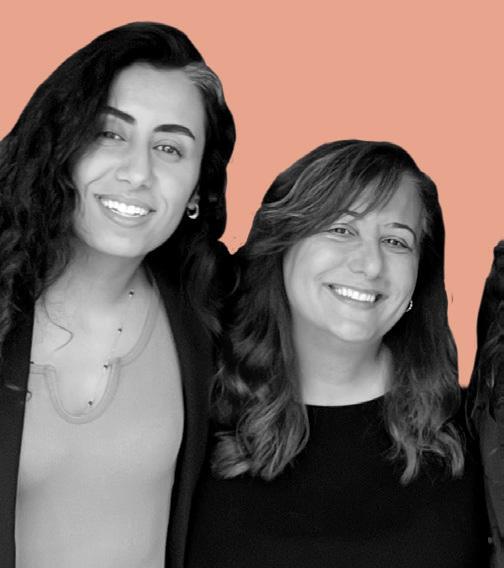
because it’s a people-first, qualityfocused and operations-heavy business. In the initial few months, training our restaurant sta , who come from di erent cultures and backgrounds, about Jordanian cuisine and the way we cook food at home was an uphill task.
To overcome this learning curve, we created an in-house programme that enables the sta to learn about culinary art, especially pertaining to Jordanian food and customer service. This not only helps them cra t great food and deliver warm service but also sets each of them up for sustainable career success in this growing industry.

What are some of the challenges you faced when starting o ?
Setting up a new restaurant from scratch comes with so many challenges – primarily
Attaining food and service consistency and quality control were also key performance areas for our team. Another big challenge that we worked through was to strike a healthy balance between the three of us, as a family and as coworkers.
“OUR GOAL IS TO BECOME THE TRUSTED GO-TO HUB FOR CURATED AND AUTHENTIC HOME-COOKED DINING EXPERIENCES FOR FOODIES AND PASSIONATE CULTURAL-CONNOISSEURS. WHAT’S MORE, WE WANT TO ENCOURAGE ANOTHER DIMENSION OF HUMAN CONNECTION OVER SHARED MEALS BY BRIDGING THE GAP BETWEEN THE DINER AND THE CHEF”
The key to overcoming all these foundational challenges lay in staying focused on our goal and working together to harness each of our unique strengths. Eva is the ‘business guru’ and a people’s person. Lilian is the one with the artistic vision that helped build this elegant brand. Her attention to detail regarding the customer journey is what ensures repeat guest visits and delight.
And Emilie is the key decision-maker behind our menu. She has a very unique understanding of ingredients and her desire to innovate with textures and fla vours has helped us modernise Middle Eastern cuisine.
What is the core concept of Three by Eva? Tell us all about its offerings. The story of Three by Eva revolves around a mother and two daughters who share a common vision: 'To share a piece of their home with you'. The sanctity of the hour around the dinner table is something that all three of us have held close to our hearts. And we want our customers to experience a similar sense of this warmth and belonging with us.
Our menu features an array of elevated Jordanian dishes, many of which are tra ditional recipes that we inherited from our mother and grandmother. Our res taurant space is split into different sec tions, the bakery, the coffee bar, the dessert bar, the hot and cold kitchen and the pantry.
How have you stayed true to your roots in your business?
As a Jordanian family in Dubai, we believe in celebrating and sharing our culture and intergenerational recipes with the local population and the multicultural dias pora. We would also like for more people to experience the generously hospitable nature of the Jordanian people.
This explains why many of our guests consider Three by Eva as a second home. They love and appreciate the simplicity of our recipes, more so when they know the story and origins of the ingredients.
For example, the jameed (mansaf sauce) is homemade with great care by my cousin in Jordan. And our pantry includes products homemade by women in Jordan, including olive oil, magdous, jams, and sauerkraut.
What are some of the growth and expansion plans you have in your pipeline?
Our vision is to spread love and forge
meaningful connections with others through food. We also want to keep shar ing our rich Jordanian culture, with people from all around the world, through our grandmother’s special recipes.
Apart from working towards continu ously elevating our restaurant experience, we are currently knee-deep in designing our new cooking school. Once the institute is operational, we will host masterclasses on how to make sourdough, traditional Jordanian recipes and a few other popular items that are currently on our menu.
We are also planning to launch a unique and invite-only supper club experience (featuring a special menu), a few nights, every week.
Any insights on food and beverage trends in 2023?
The food and beverage industry is grow ing at a rapid pace. We have seen so many new restaurants opening during the past year, especially after the easing of Covid19 restrictions.


An important trend to note is that ever since the pandemic, consumers are gravi tating towards traditional food prepara tions that remind them of home. This is why we see more charismatic home grown restaurants, like ours, offering ‘comfort food’ across the Middle East.

Consumers are also keen to eat healthier, sustainable and wholesome meals, while seated in an elegant and unique setting.
There is also more momentum around sustainable packaging and operations than ever before. And it will likely carry over to 2023.
“THE STORY OF THREE BY EVA REVOLVES AROUND A MOTHER AND TWO DAUGHTERS WHO SHARE
A COMMON VISION: 'TO SHARE A PIECE OF THEIR HOME WITH YOU'. THE SANCTITY OF THE HOUR AROUND THE DINNER TABLE IS SOMETHING THAT ALL THREE OF US HAVE HELD CLOSE TO OUR HEARTS”
company at this stage, claiming imperial power as “chairman” is simply ridiculous. Don’t fret about it, and just work through the agenda.
Speaking of meeting agenda, keep it simple, but make it an accountability tool. Everyone involved should know how var ious metrics stand at the moment, but a board meeting is a good way to assure that you are all looking at the same num bers at the same time (most of the daily information is likely going back and forth in bits and pieces). Expect the founder to put together a proper set of financials and updates for the meeting and also a progress report on output development and sales.
The board in turn signs off on any share issuances, term sheets, contracts above a pre-set amount, and other necessities. Some of these can be legally approved on the fly in the course of business but bring ing the board together to discuss as a group keeps everyone on the same page.
While Dubai has the poten tial to become a global startup city, startups face many challenges and uncertainties ranging from economic growth needs and funding gaps to talent acquisition and retention. A good govern ance system will help them avoid the many hurdles that are on their course.
The good thing about startups is that they can reach out to the many retired executives who have time and expertise on their hands and that have an unfulfilled desire to serve a board.
How to shape a board that can turbo charge a startup or new venture that is bootstrapped for growth is a different topic altogether. But assuming that you have got a board plan in the works, what should you do with it?
Young companies usually have neither time nor interest in adhering to board meeting formalities that include rigid agendas or “vote to amend the motion on the floor” kind of parliamentary niceties. Even then, early, smart meet ing procedures benefit them, closing
critical governance gaps and assisting with growth prospects.
What sort of a “mini-agenda” makes the most sense for startups?
Start with setting a regular calendar for board meetings, and sticking to it no matter what. For venture startups, a monthly schedule is just about right and makes it clear that everyone on the board – found ers, funders, mentors or any observers – are expected to attend virtually or in person. Yes, everyone is already overstretched building the company, and you are all in day-to-day contact anyway. But imposing a regular “time out” for specific govern ance matters compels all of you to switch the hats you wear on development, dealmaking, sales, etc., to think like a board for a couple of hours. Stepping back this way will prove invaluable in planning for stra tegic gaps.
Since most startup boards are likely three to five people, all with some level of ownership power, don’t get hung up on who’s named chairperson. The founder, a co-founder, or an early investor on the board shall run the meeting, but for a
The agenda should include dedicated time for strategy and should cover not just next quarter targets, but longer-term issues on funding, product timelines, partnering opportunities, talent acquisition and so on. Interestingly, Sequoia Capital perhaps because of their recent governance set backs in their invested startups, set in place a simple agenda for early-stage startups that drills down on these items. They have also offered suggested times – but we feel working sessions on strategy deserve dedi cated time rather than what was proposed.
Designate an assistant to minute your board meeting. This may seem like fussy busywork but proper minute-taking is a legal requirement, and assure everyone has a shared record of what was covered. It will be a handy listing of who promised to do what and by when.
Finally, when board members are in multiple locations, it may be time to use a VR/AR-based meeting tool where they can all have the same meeting room as the venue with their avatars in place of staid Zoom images. The costs of AR/VR gear will be a small fraction of actual board meet ing costs without much loss of emotional involvement. This is where the next level of boards will meet and what better way than this for startups on a shoestring.

When it comes to a meeting agenda, keep it simple, but make it a tool to enable accountability






